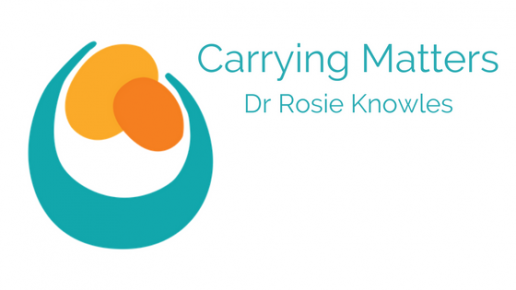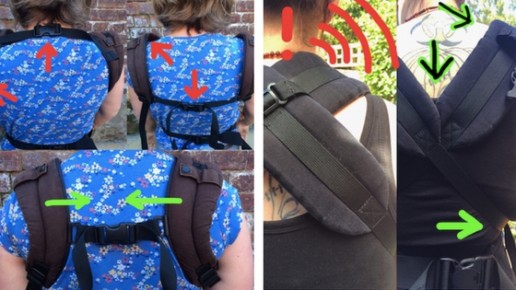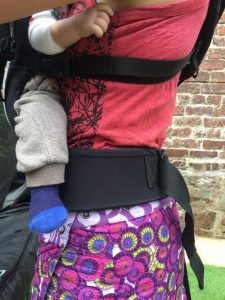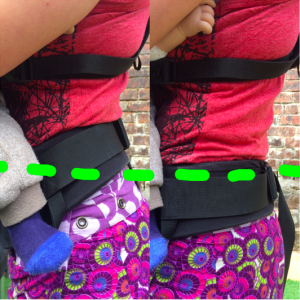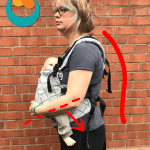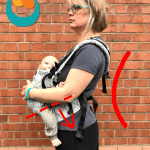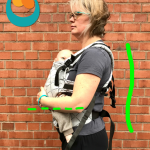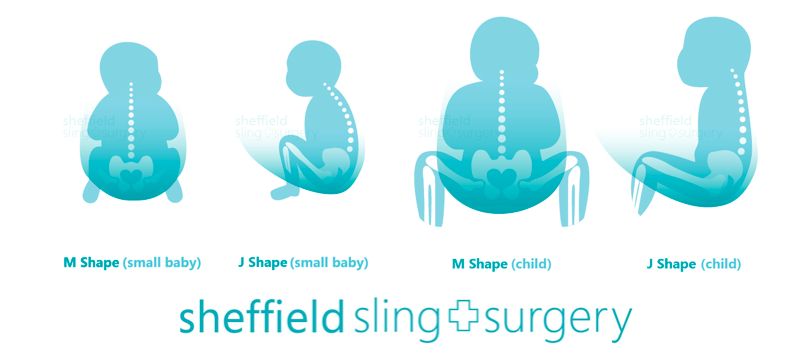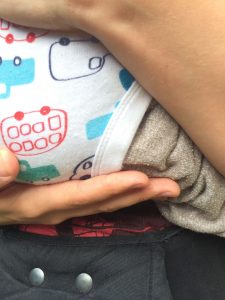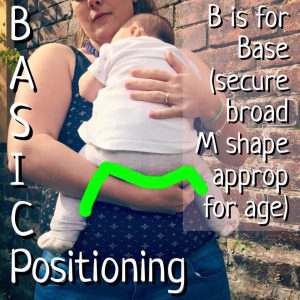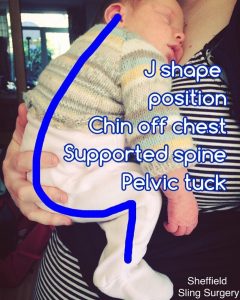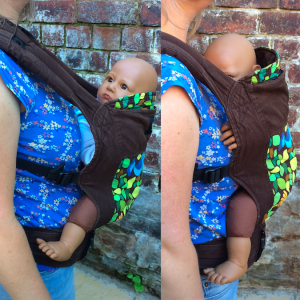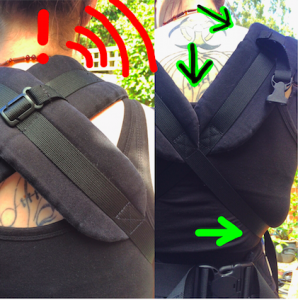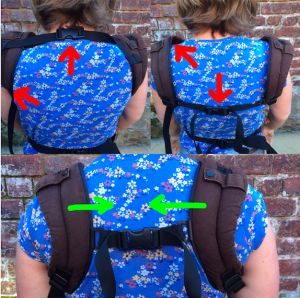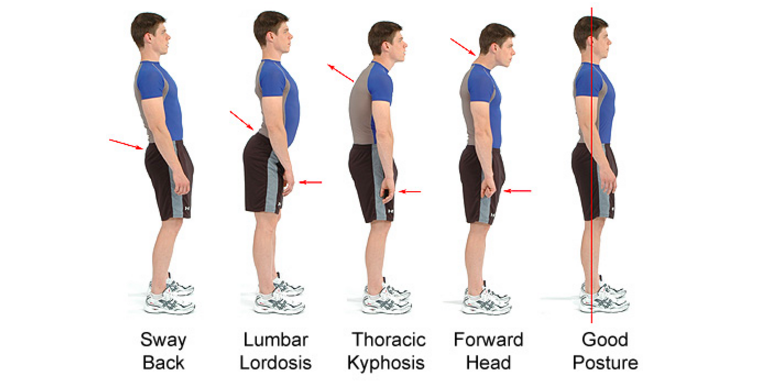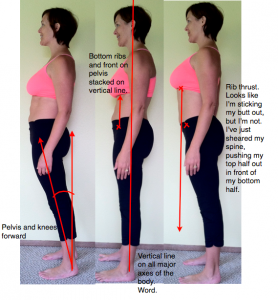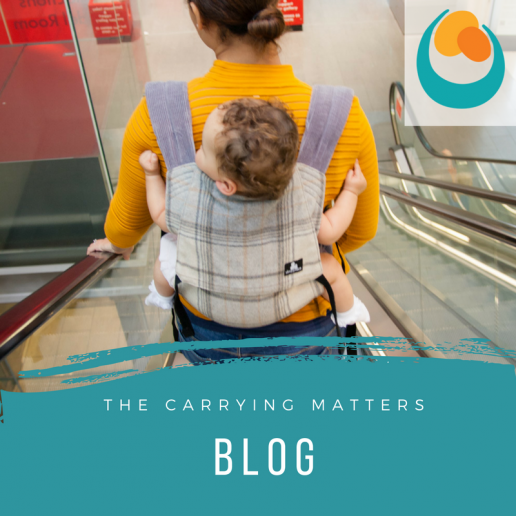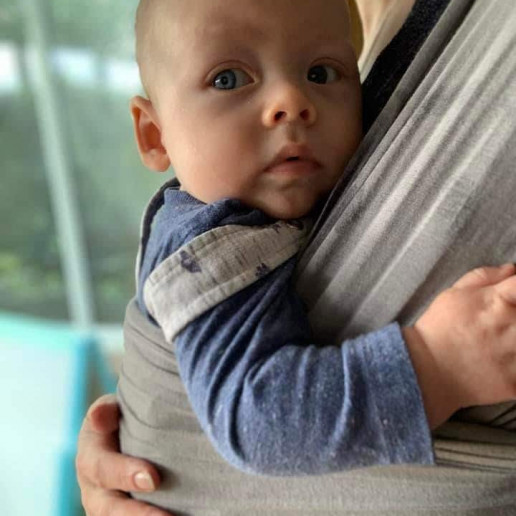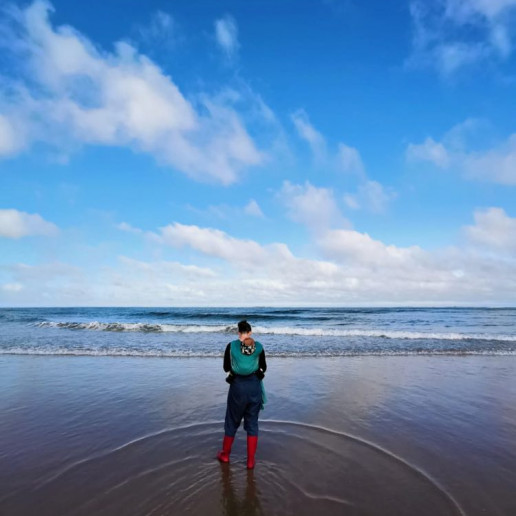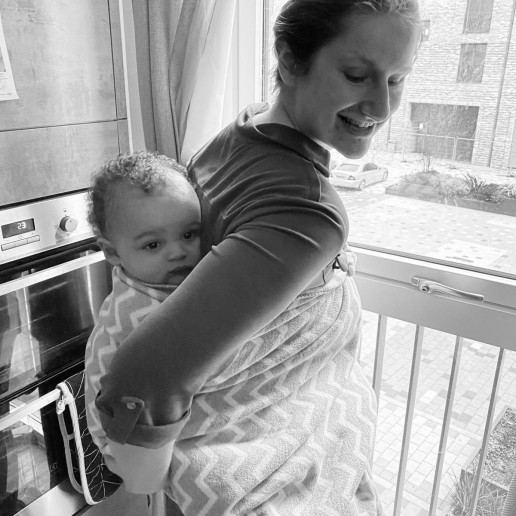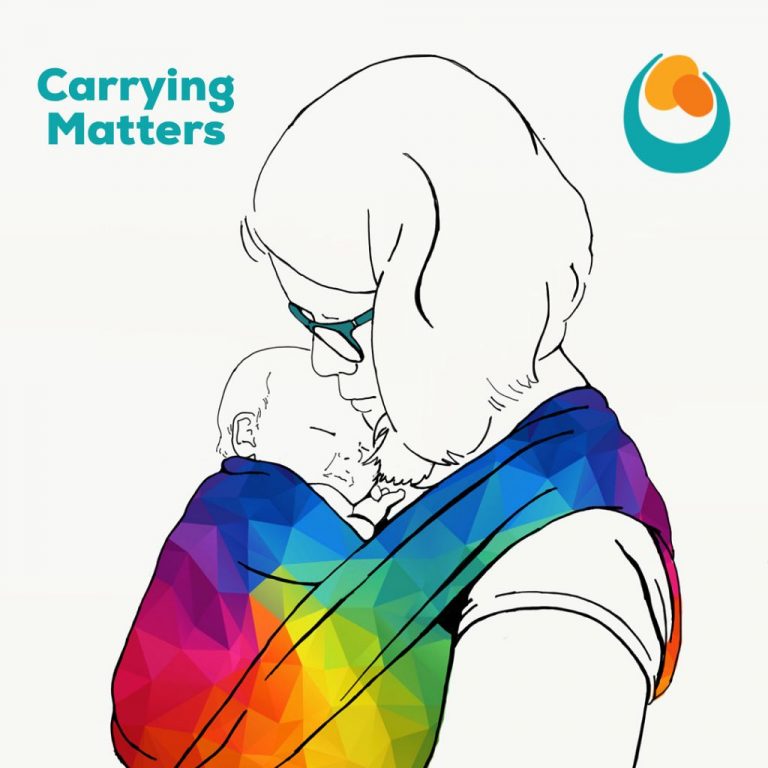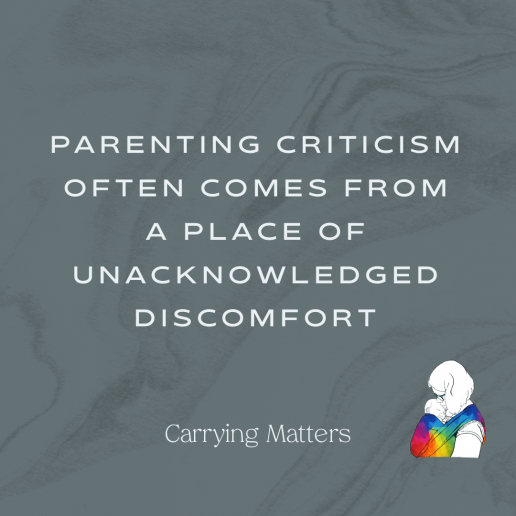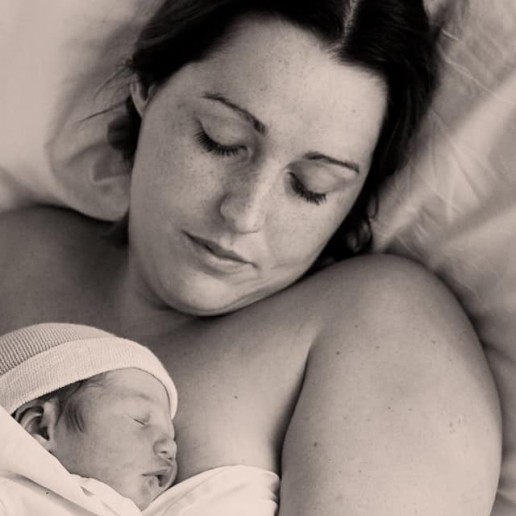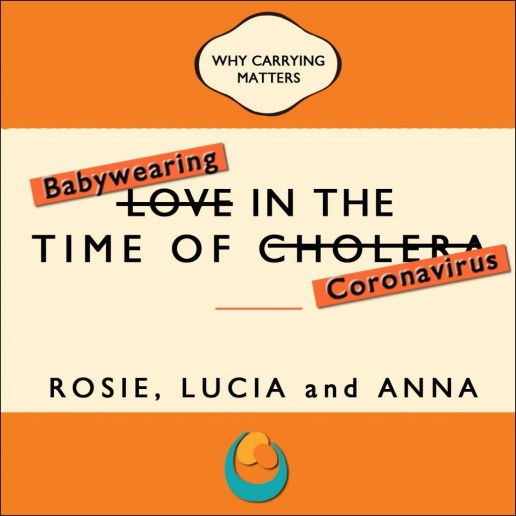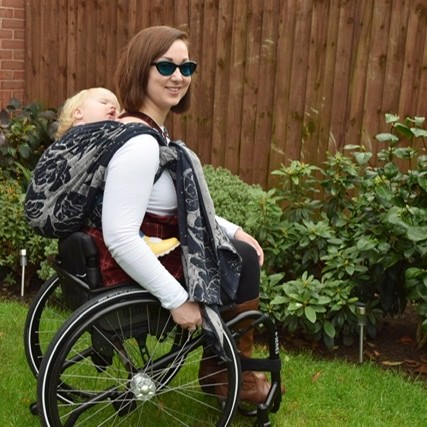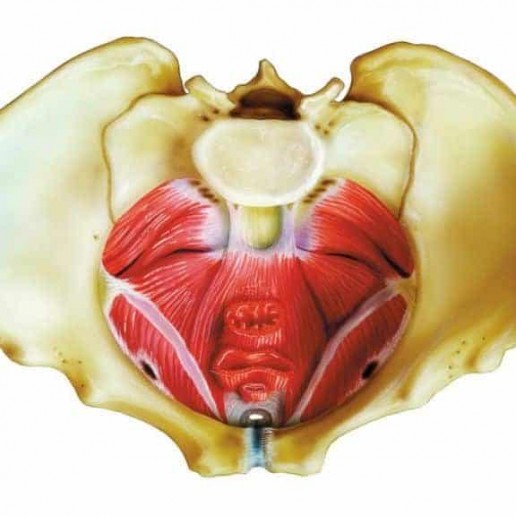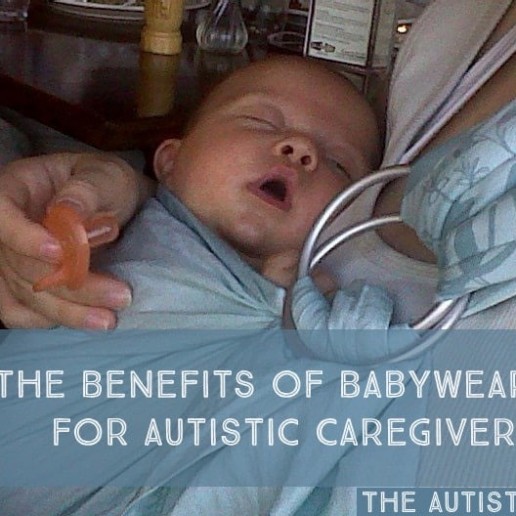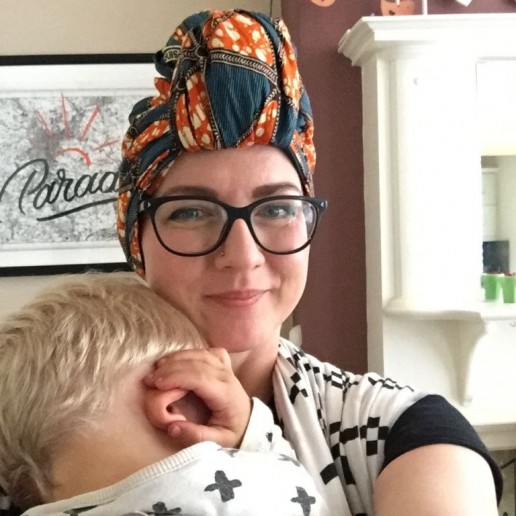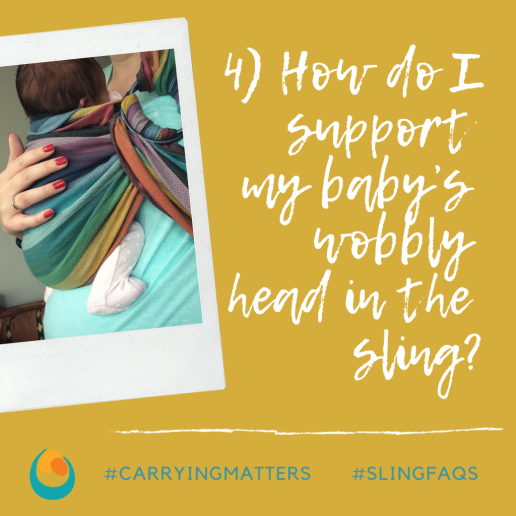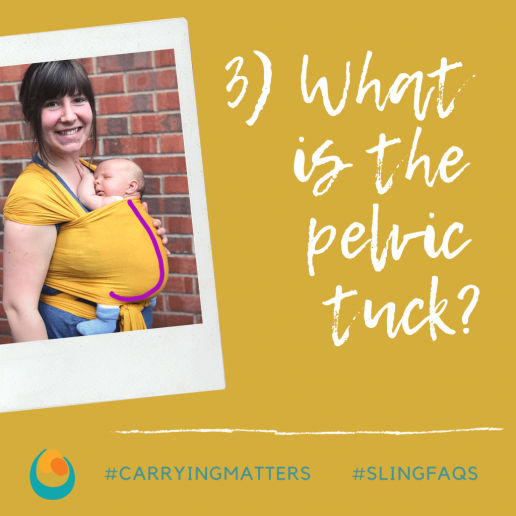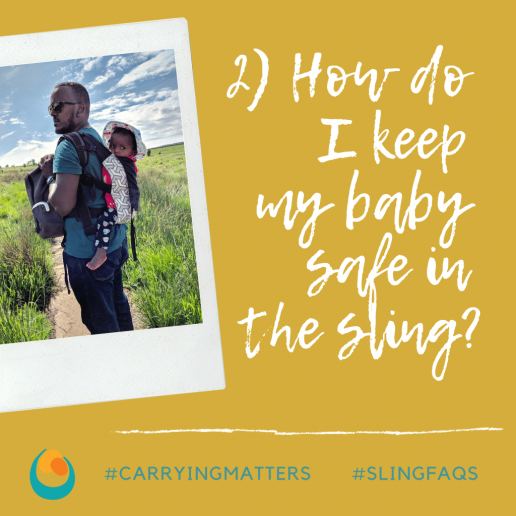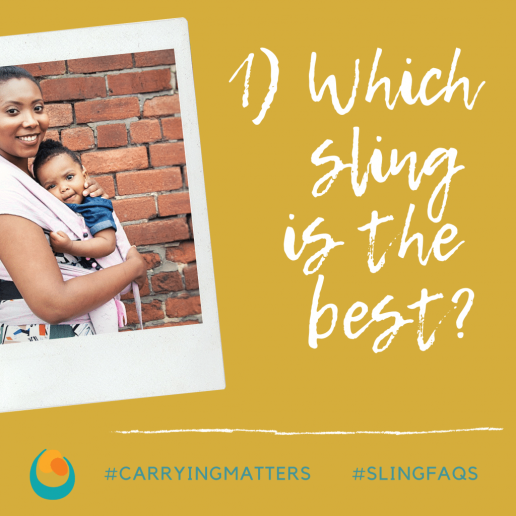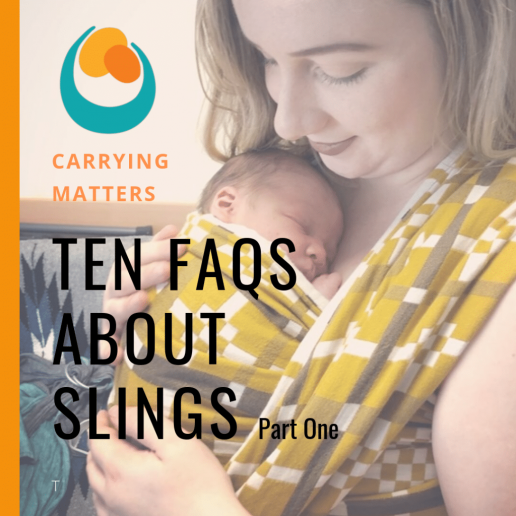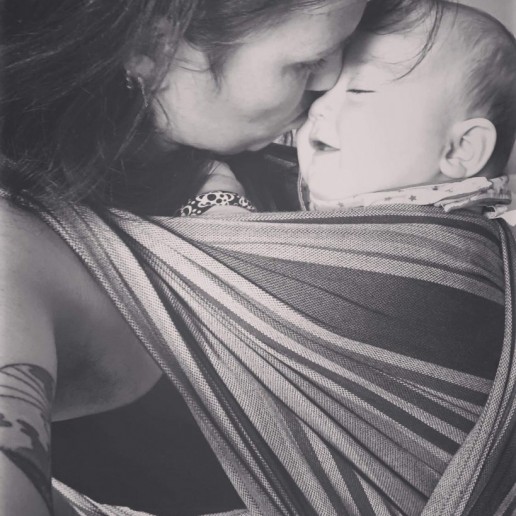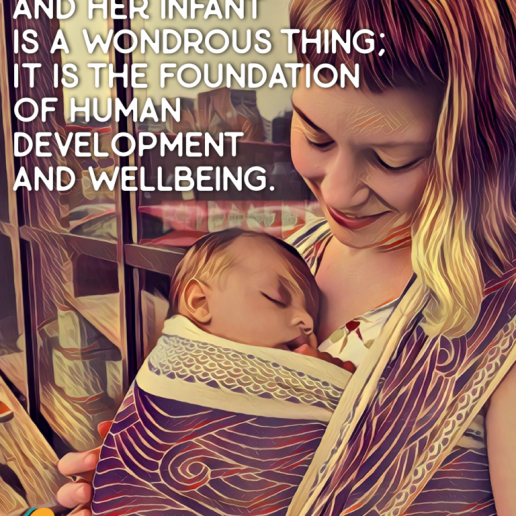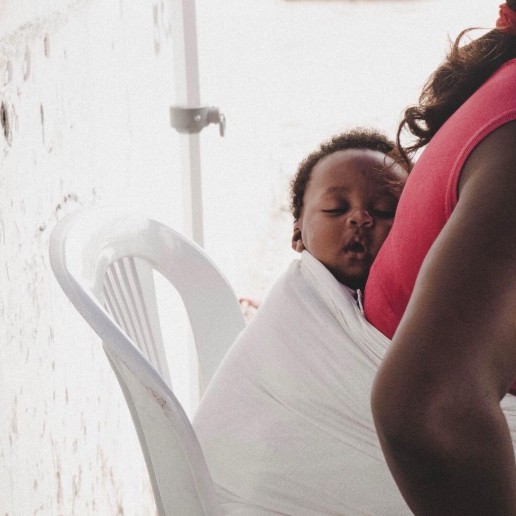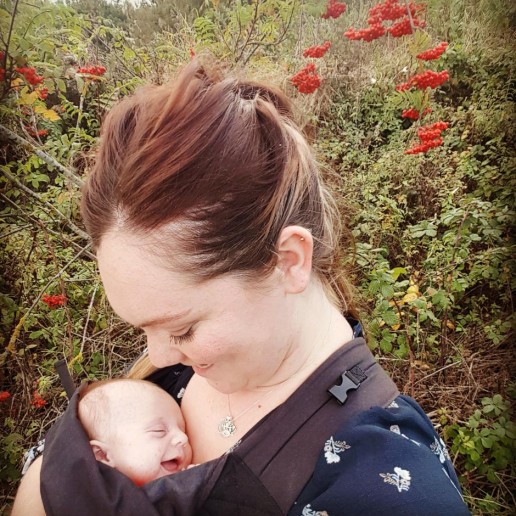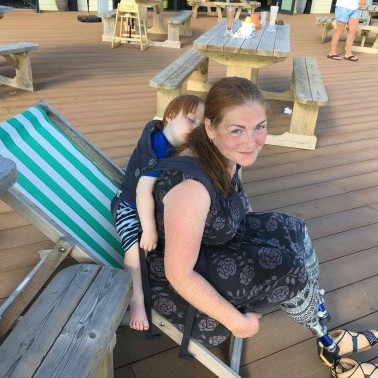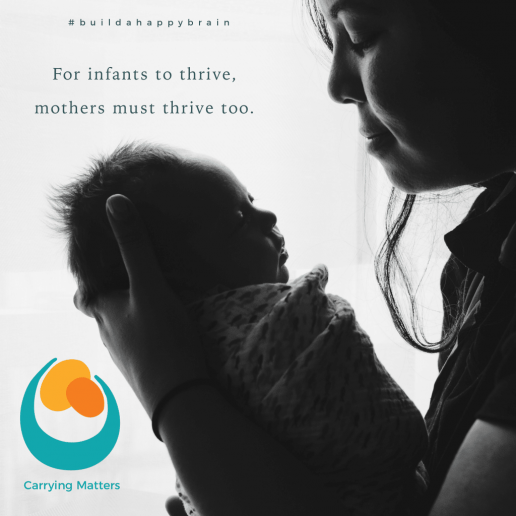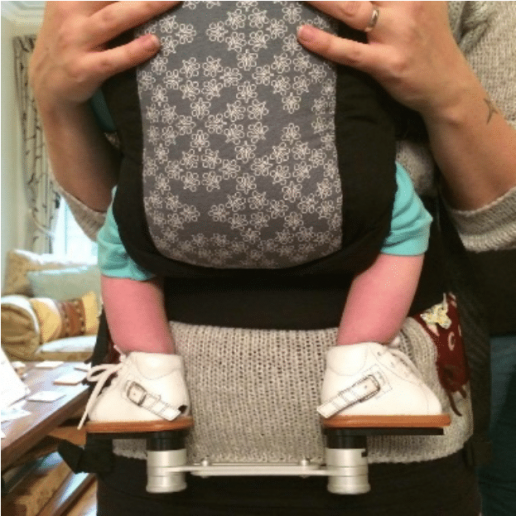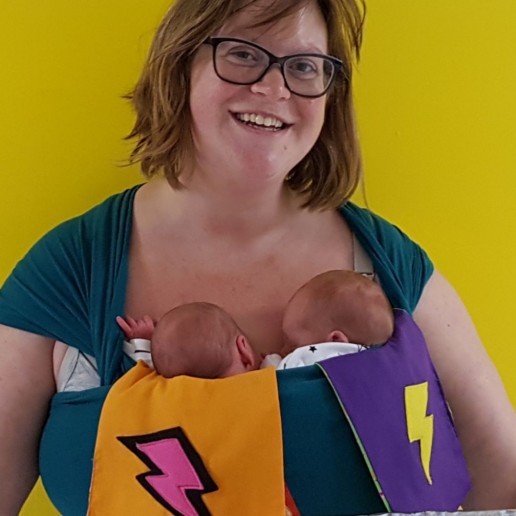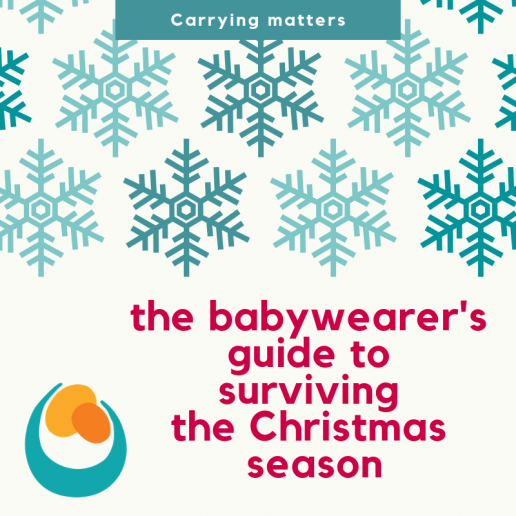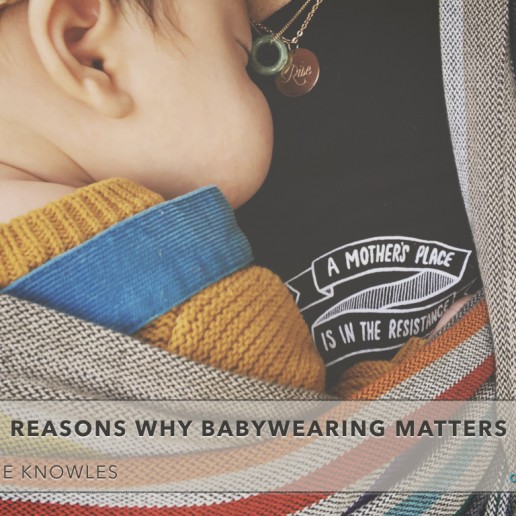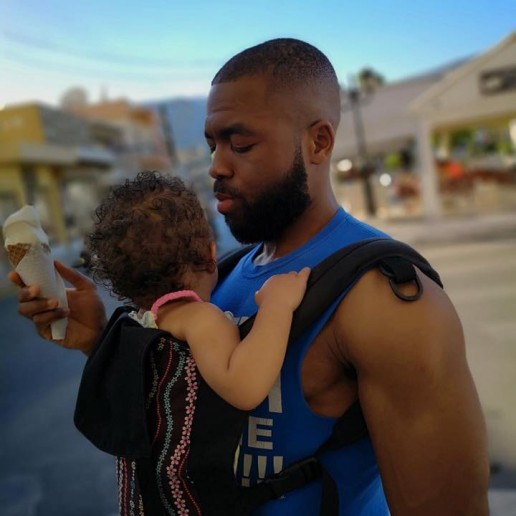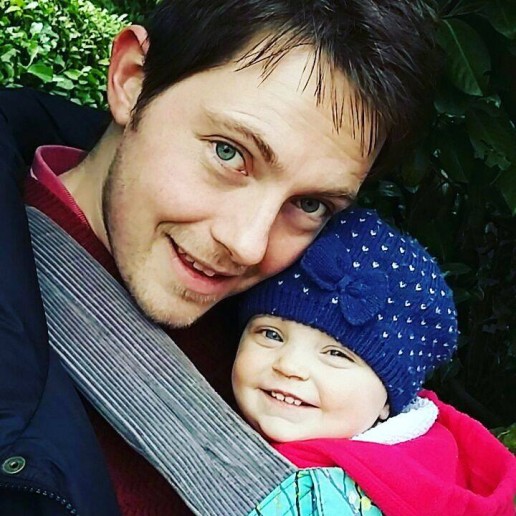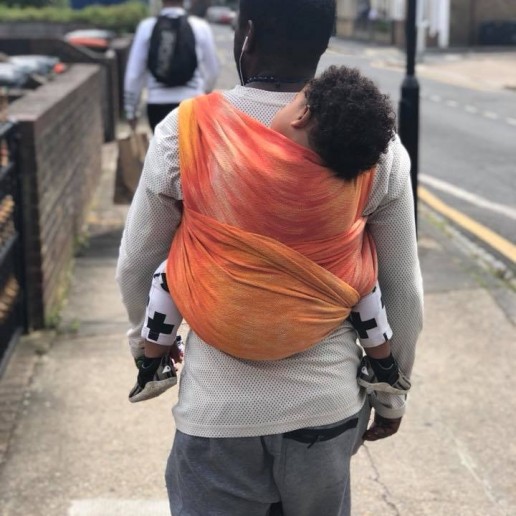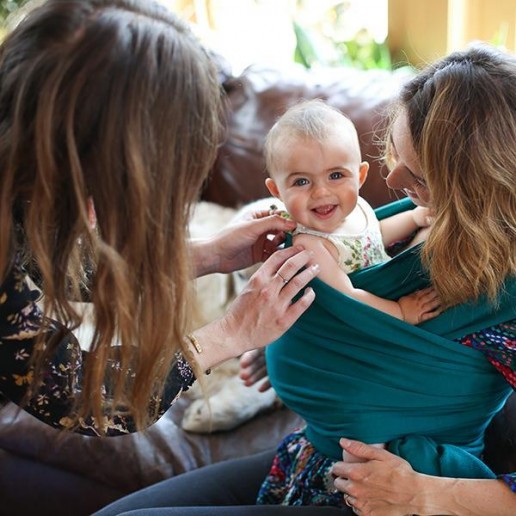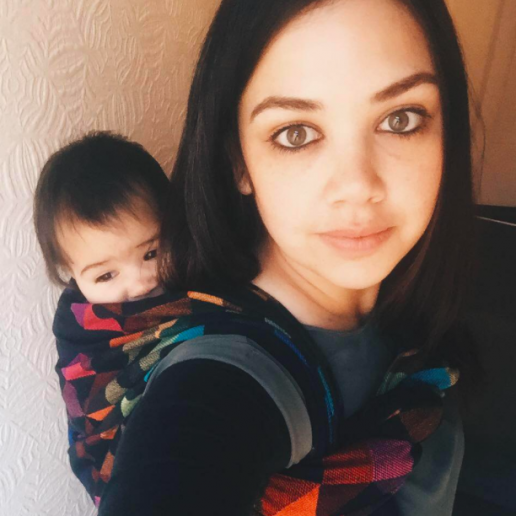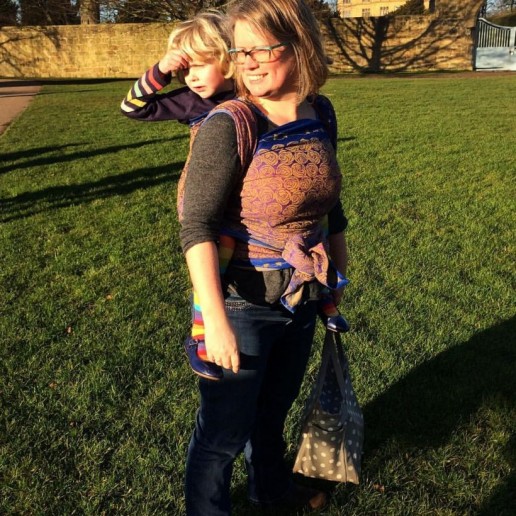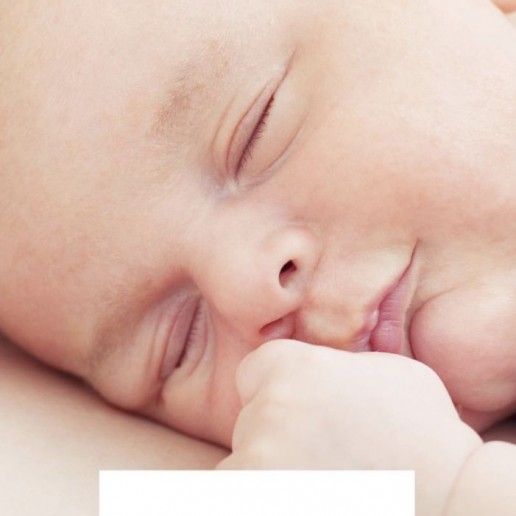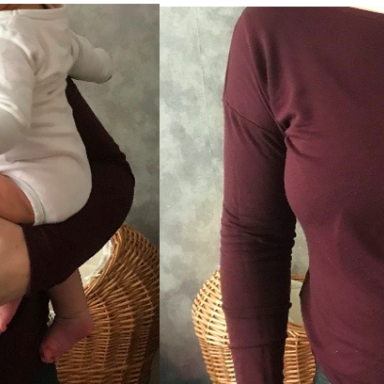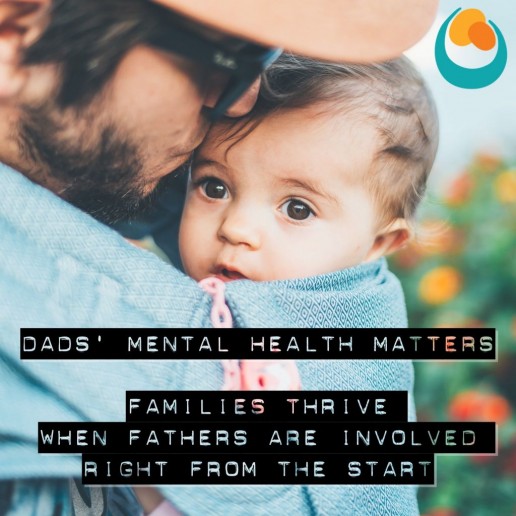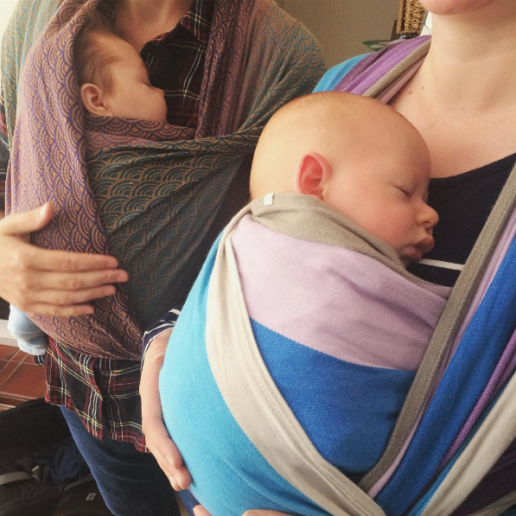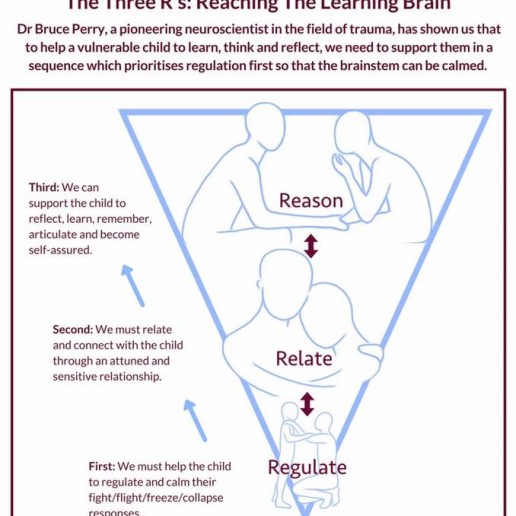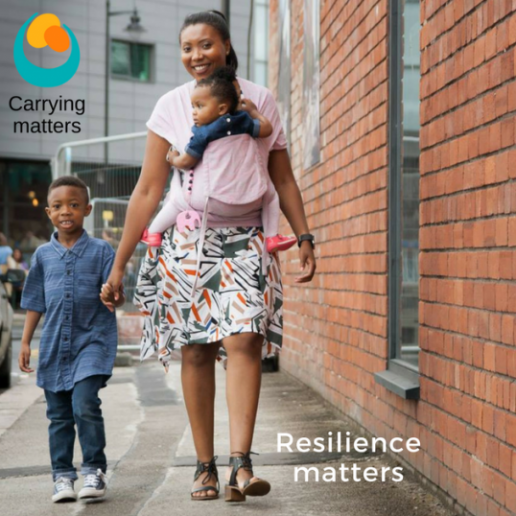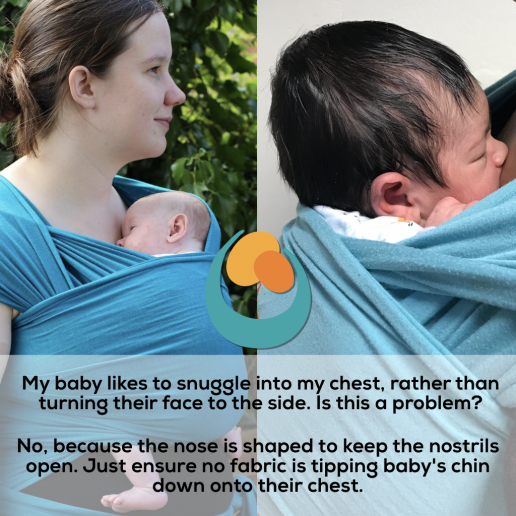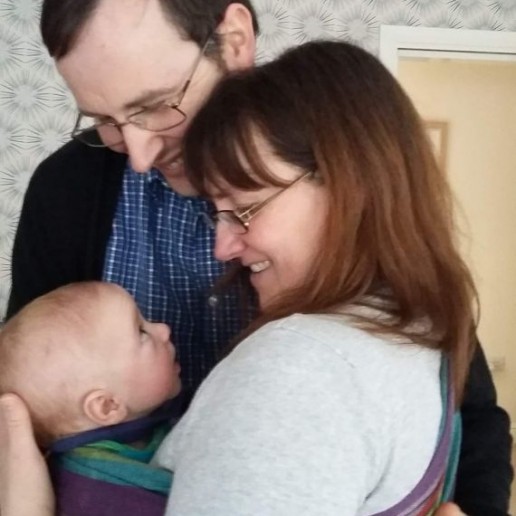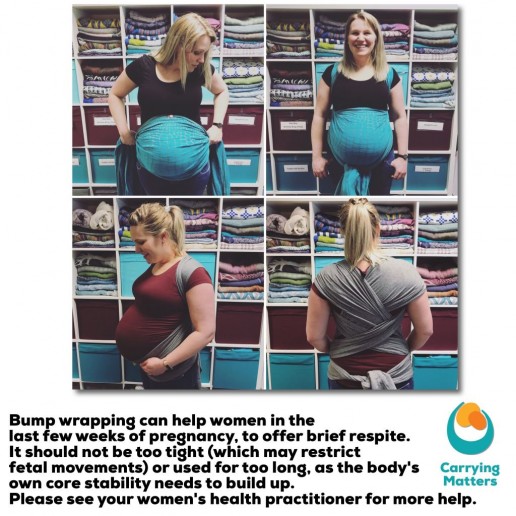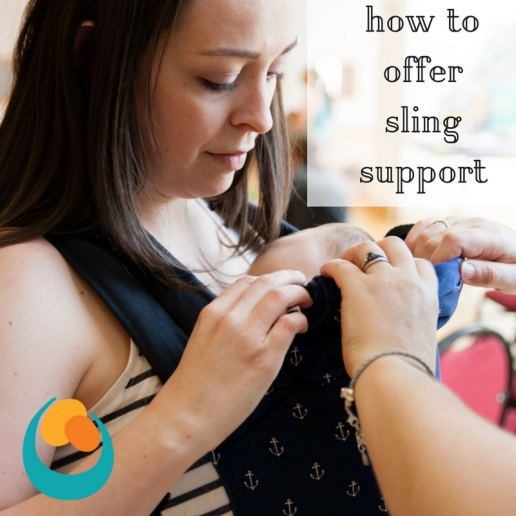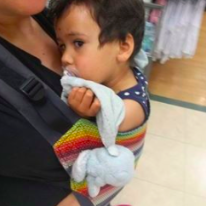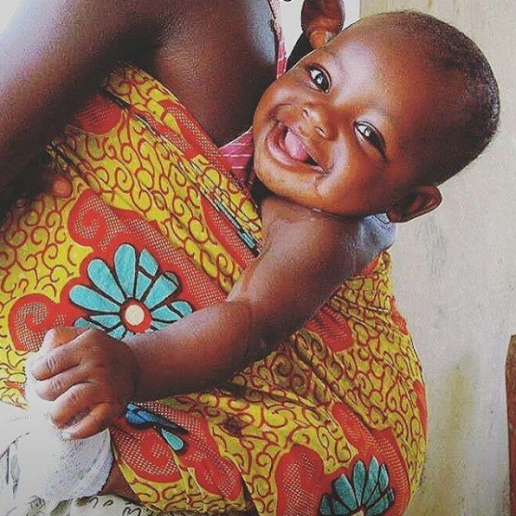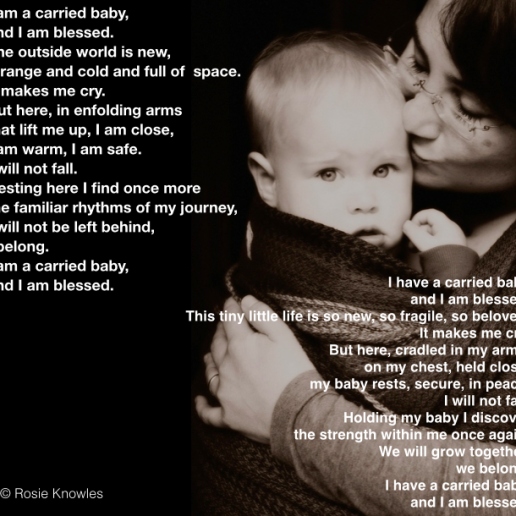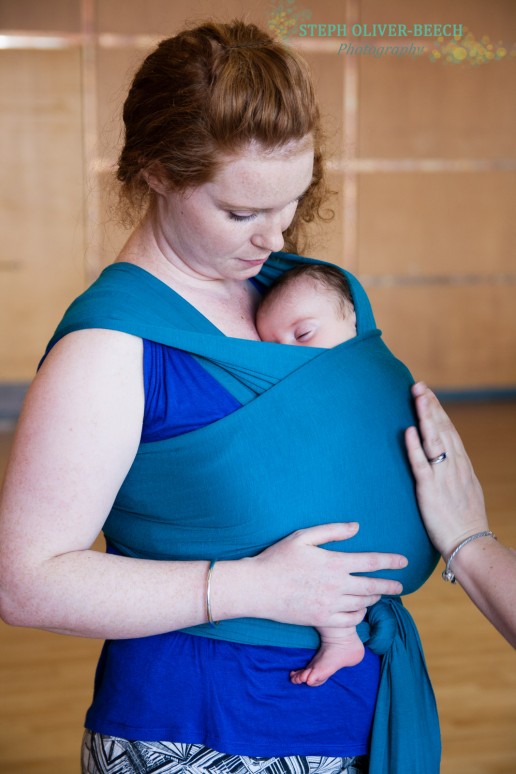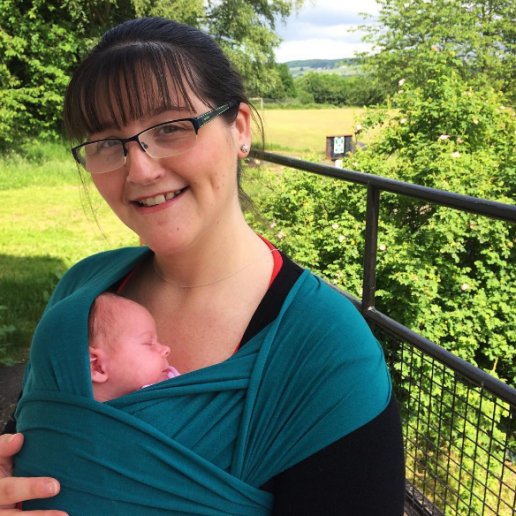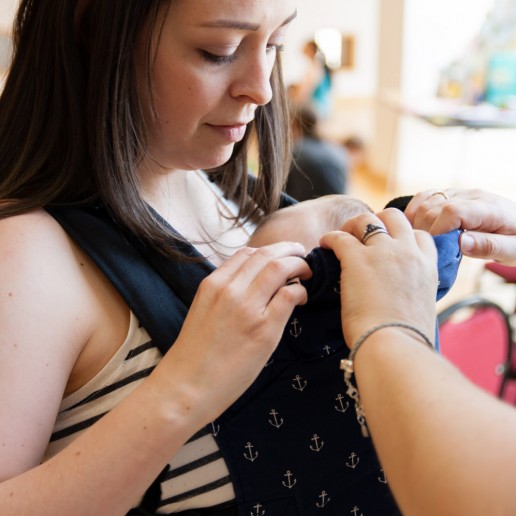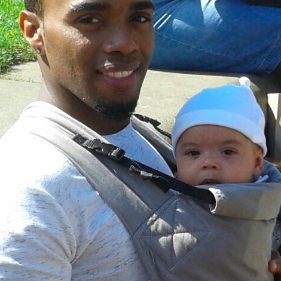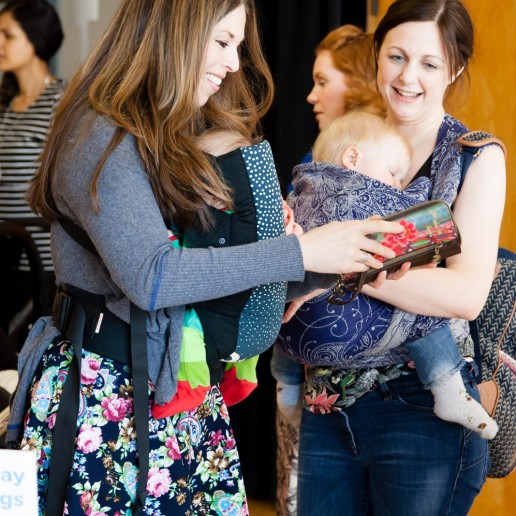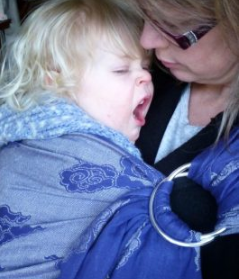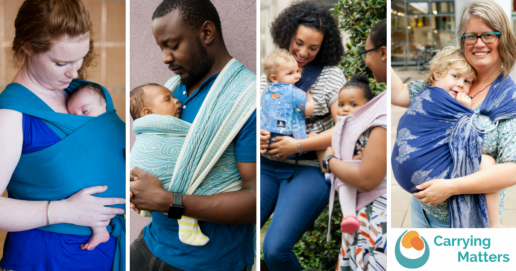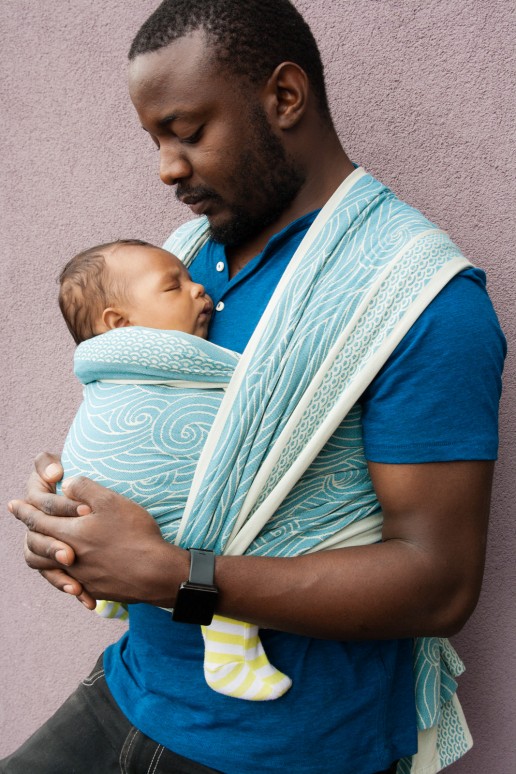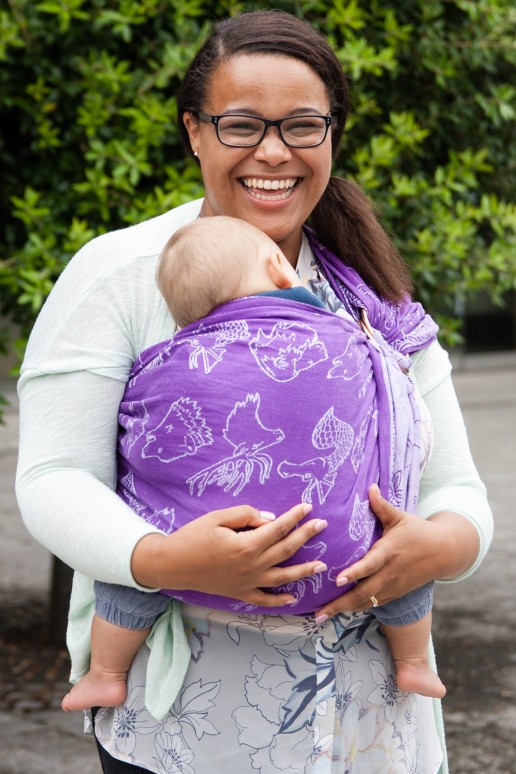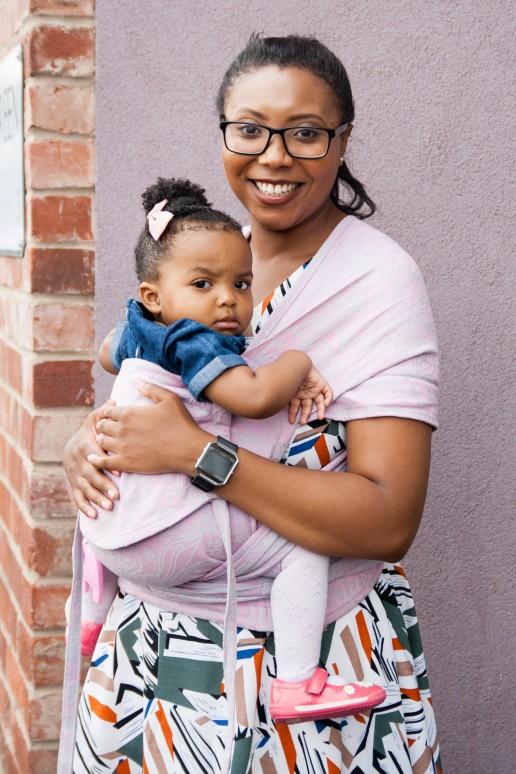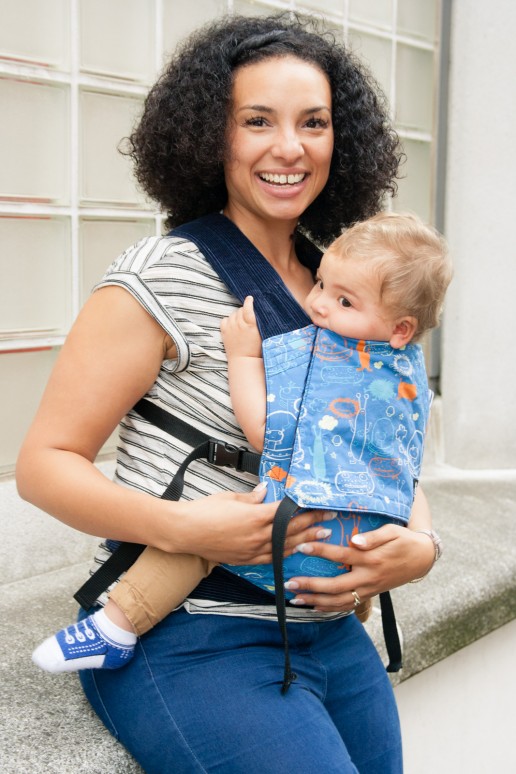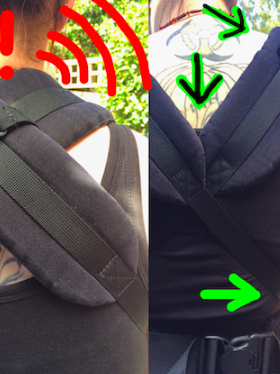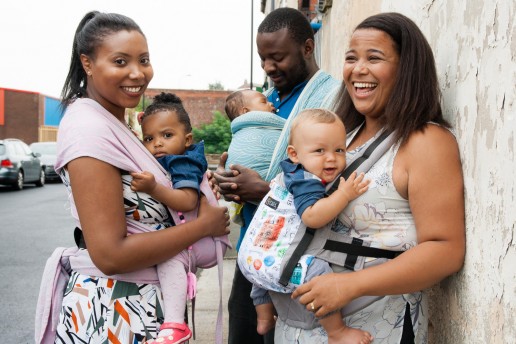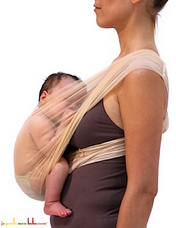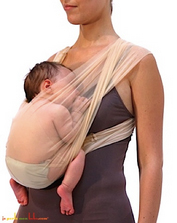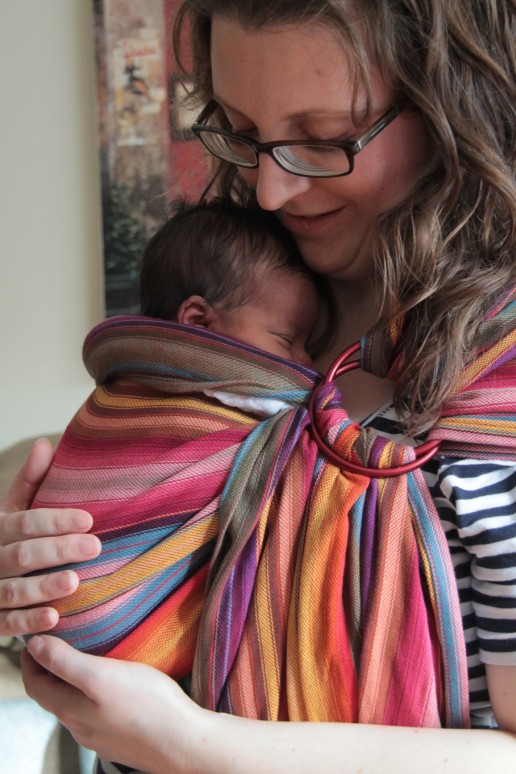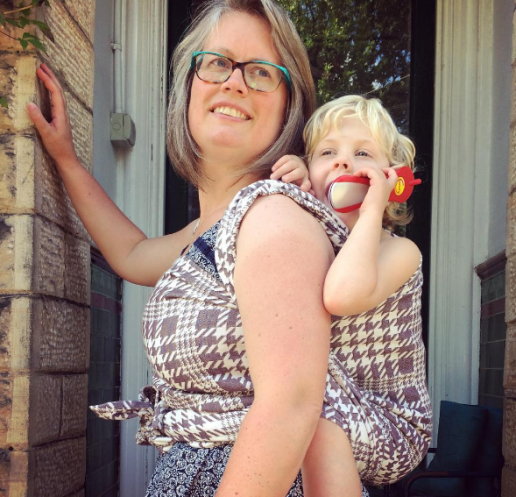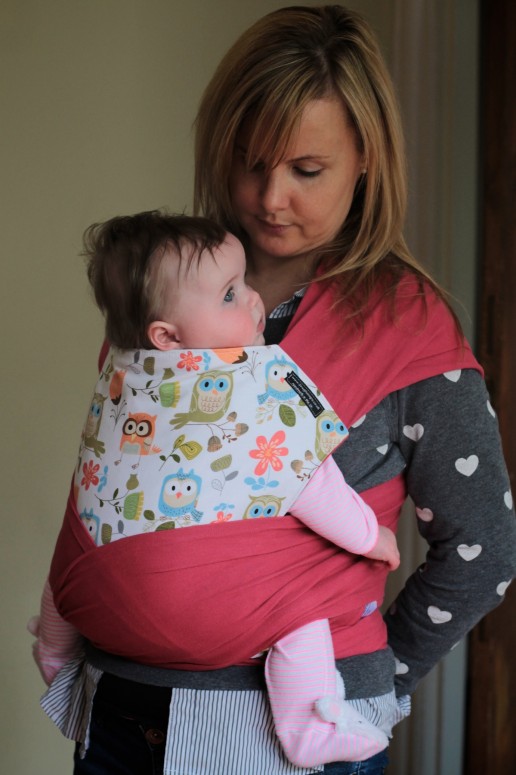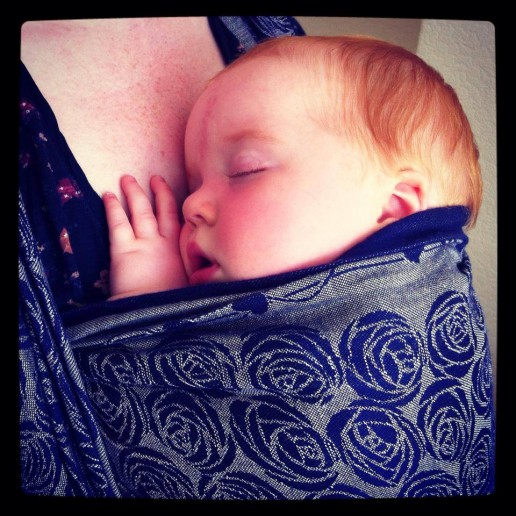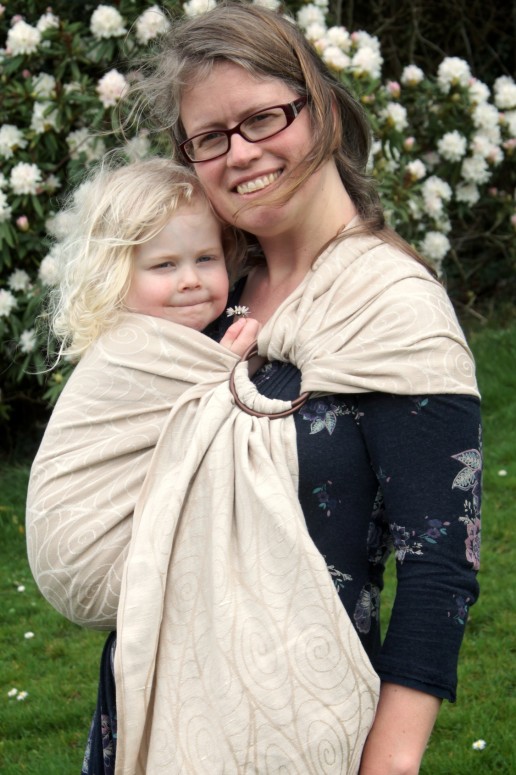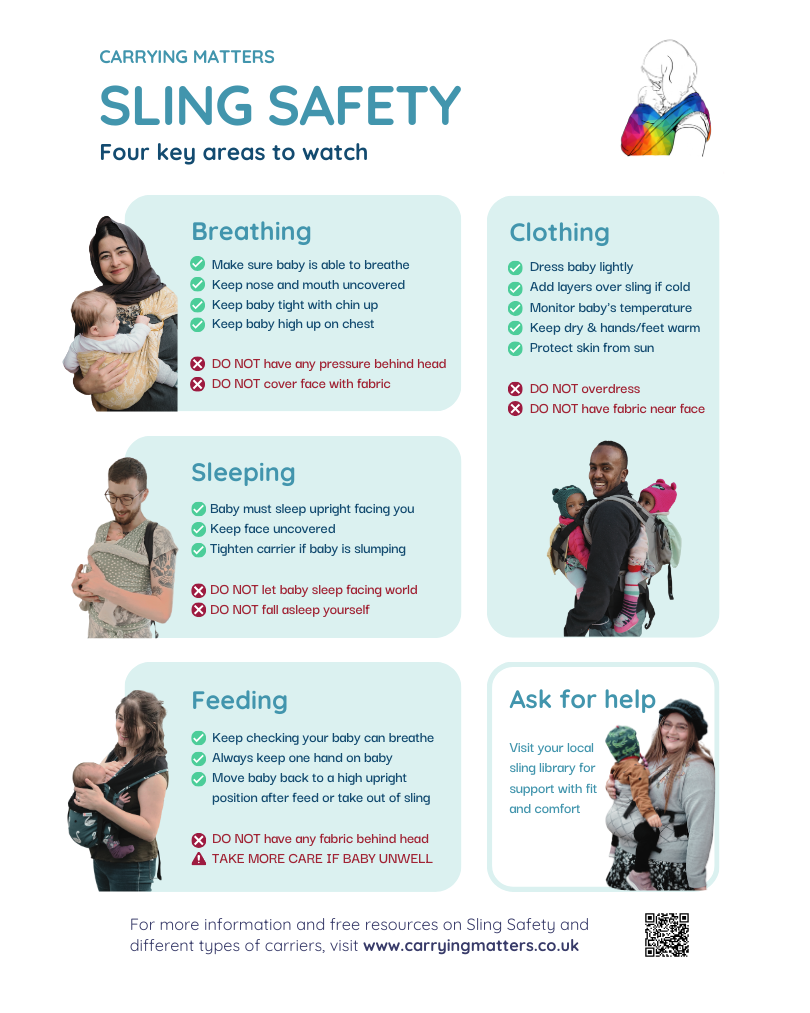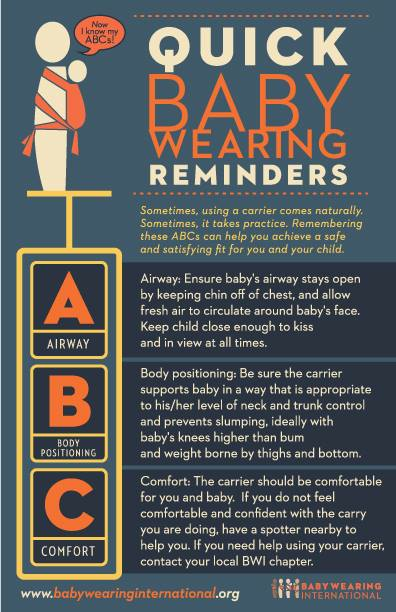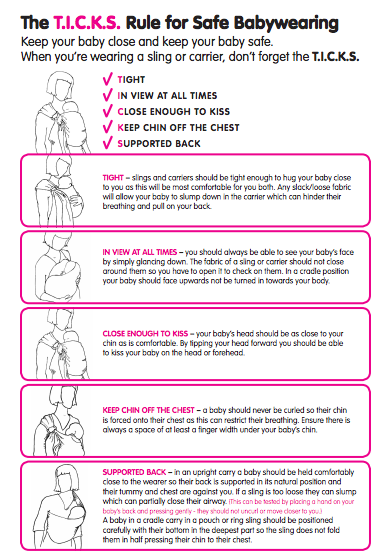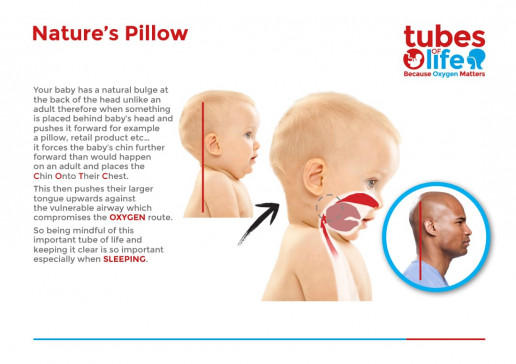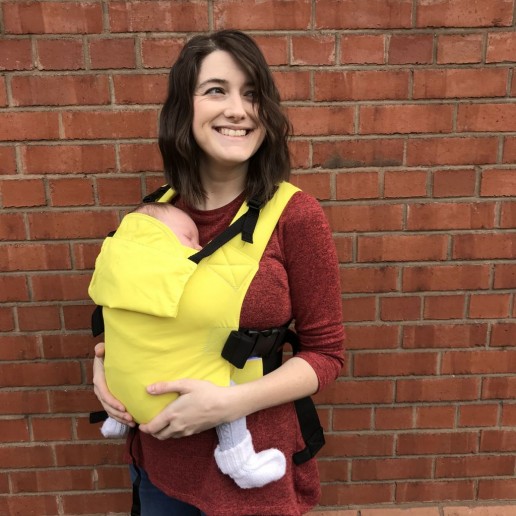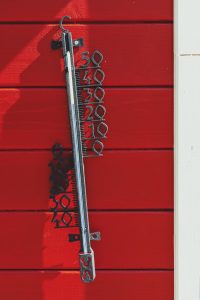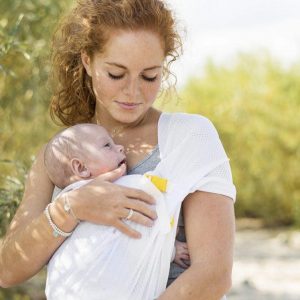Troubleshooting your buckle carrier
Want to make the most of your buckle carrier and ensure it is as comfy for you and your child as possible? Here are some troubleshooting handy tips to help!
Before you start, check your carrier over for wear and tear, ensure the buckles aren’t broken, loosen any webbing that was left tightened, prepare anything that needs pre-clipping etc. Make sure your carrier is the right size for your baby.
Work on your waistband
- Choose where to place your waistband. This will depend in part on the length of your baby’s torso (the top of their head should be at least close enough to kiss, for airway protection. or higher). This may mean you need to wear the waistband quite high when your baby is small, as free airflow is vital. As they grow longer, the waistband can move further down your body!
- Waistband-less carriers (for example, the Integra) are positioned mainly for baby’s height and may need to be quite high for little babies as their bottoms sit lower than the webbing waist.
- Some people like to have the padded waistband right around their natural waist. If it is a wide or stiff band, try to have the lower end at least skimming over the top of your pelvic crests, rather than sitting on top, which may make it more comfortable.
- Some people find placing the padded waistband around the upper part of the pelvis helpful; this means that the weight does not rest on top of the pelvic crest and the waistband won’t dig in. Too low down may make it hard to walk. Try a few heights out!
- As your child grows your waistband is likely to need to move further down your body (which will also help you to see over your child’s head!)
- Make sure your waistband sits parallel to the floor rather than tipping forwards to be lower at the front. This distributes weight more evenly.
- The waistband does not need to be super tight; it just needs to be secure so it doesn’t slip.
- Ensure the buckle is fully clicked together.
- This post about babywearing with a weakened pelvic floor is worth a read, it shows some very helpful images of posture.
Practice your position
- Hold your child in the ergonomic M and J shaped position you are hoping to achieve, in the location on your body you wish them to be. It is worth taking the time to do this; it is much easier to bring the panel up over a well positioned child at the right height, rather than having to do a lot of fiddling or adjusting later. Their chest should be close to you, chin off their chest, with no slumping over. (see more here)
- It helps to have your child’s bottom a finger-breadth above the padded waistband. This will help to ensure the panel does not get bunched up underneath baby, which will shorten the panel. (Of course, if you are shortening the panel or using a waistbandless pouched-style carrier this does not apply).
- Hold your baby in the correct position and location with one arm, resting against you, and then with the other hand, reach underneath the panel and smooth this up your baby’s back.
- If you are using an insert, make sure your baby is positioned correctly on the seat and that little feet are not being squashed but are resting on either side of the insert.
- Ensure you have a good pelvic tuck. This maneouvre encourages your child to sit in the carrier seat with their weight resting on their bottom. not in their knee pits. It encourages their spine to curve gently and will allow them to relax into you, making carrying easier.
Sort your straps
- Weight distribution is most effective when baby’s centre of gravity is closer to yours. This can be achieved by making sure your shoulder straps are snug enough to keep your baby’s chest and tummy in contact with your front, without slumping or leaning back. This will stop your shoulders and neck and from feeling pulled forwards (and prevent your lower back from having to compensate for this strain).
- Too tight straps can be uncomfortable as well; find the happy medium.
- Crossed straps that are positioned too close to the neck will be uncomfortable. Pull each strap vertically down your back and taut, before you bring it round your side to clip into the buckle. Move them further out onto your shoulder and make sure the cross is in the middle of your back before you tighten. You can use any curves that you have to help position the webbing straps and keep the cross low. Too tight straps will tend to ride up to the narrowest point.
Here is a video showing you how to fix this if you haven’t got it quite right.
- Ruck straps; the key to getting ruck straps to work is the position of the horizontal belt across the back; how high or low it sits, and the shape of the straps themselves. Too high can lead to cutting into the back of the neck, and makes the straps push up into the back of the armpits. Too low will reduce any armpit digging but can also lead to lift-off of the straps from the shoulders. Everyone has a “sweet spot” with the belt and the straps; generally somewhere in between. Get the belt right first with the help of another person, and then pull the shoulder straps snug, little bit by little bit. Pulling one side fully snug will shift the whole carrier over to the tightened side and distort the carry and be uncomfortable. This is one reason why the lift-over-the-head preclipped method of getting the carrier on can be much easier, you are not limited to a position that you can reach behind to.
Click here for a photo tutorial of this method.
Here is a video of this method.
Perfect your posture
- Many of us suffer from discomfort when carrying; much of this will be down to how we stand and how well we are aligned. Addressing your musculoskeletal health is a vital part of any carrying journey, indeed it is part of your overall wellbeing. Standing with a forward slump or rounded shoulders, or with your head hanging forward, will all distort your centre of gravity. This will mean that adding a weight to your front, however well adjusted your carrier may be, will cause strain. (image from Phi Fitness)
- All your major axes should be in alignment. Your head should be in line with your shoulders, and shoulders above your pelvis, which in turn is directly above your knees and ankles. It is common for people to have a pelvis that is not in neutral positioning, which significantly affects your spine and your shoulders; all our joints are connected to each other. Many of us walk with a strong forward lean due to tight calf and thigh muscles. Working on loosening these muscles to increase flexibility and adjust how we stand is very important, as is foot health.
- It is worth looking at yourself side on in a mirror and watching what happens to your posture as your carrier goes on, and what it is like after ten to twenty minutes of carrying. This will help you to gradually work on how you stand as you carry and improve your comfort. (Image from Nutritious Movement/Katy Says blog)
Take your time
- Carrying loads requires a gradual build up of strength, just as training for any exercise. Muscles tone and become stronger with use. Increase the amount of time you carry your child bit by bit, massaging and winding down your muscles after any discomfort.
See your sling library for help
- you can find your local resource here www.slingpages.co.uk
Blog
The Carrying Matters blog page.. enjoy reading! If you have any topics you'd like to see covered, get in touch! I enjoy writing and am always keen to hear of new ideas, and to host guest blog posts too!
I am a Carried Baby
14th December 2017
Why do we carry our babies? We carry them because it is a biological, instinctive parental response, that blesses the children we carry, and that blesses us. I find myself blessed by the small part I…
Can I carry my baby in a sling if I have epilepsy?
16th November 2017
Guest Blog from a friend of mine about her choice to use a sling to keep her child close despite her diagnosis of epilepsy. It has worked out very well for her. Here she discusses the processes of…
Breast and Bottle Feeding Safely in a Sling
5th August 2017
I meet a lot of pregnant ladies in the course of my varied roles, and many new mums, and one of the questions I am most frequently asked is "Will I be able to feed my baby in a sling?" It's an…
Guide to Slings
A guide to slings: choosing to carry your child is just the start of an adventure you can share together and both derive a great deal of enjoyment from! It can often feel overwhelming, trying to decide what to try first when there are so many options and everyone has their own favourites. Our guide to slings is designed to help you understand the basics of safe sling use and to know more about the major types of sling.
Useful videos can be found here and the photo tutorials here.
Read more about Common Queries here (such as facing out, carrying in the post-natal period, healthy hip positioning)
Read more about Carrying in Special Circumstances here (such as carrying while pregnant, carrying older children, carrying premature babies)
Do get in touch if you need some help.
Sleeping while your baby is sleeping in a sling
Sleeping while your baby is sleeping in a sling - is this safe?
Imagine the scenario, familiar to all of us.... you are a very tired parent, with a new baby who doesn't seem able to settle down in their Moses basket or cot, and will only sleep when held and rocked. Your baby cries when he is laid down again, no matter how deeply he seemed to be asleep on your chest or your partner's shoulder just a moment ago. This is where you might turn to a baby carrier (typically a stretchy wrap, or a ring sling, sometimes a buckle carrier or a meh dai), which keeps your baby close, in the supported position she loves, able to hear your heartbeat and breathing, everything smells right, it is warm, she is surrounded snugly with gentle pressure all over and not flailing freely in open space. (See here for more information on the "fourth trimester" theory of meeting baby's needs.)
So far so good, your baby is positioned well in the sling, airway is protected, breathing is unobstructed, spine and head are well aligned with a supported upper back and a gentle curve into a tilted pelvis. You can see that your baby's face is visible and he is close enough to kiss, there is no slumping, your rocking movements (swaying, walking) and precious closeness and feeling safe in your arms has worked its magic, and your baby is at last, peacefully and contentedly asleep.
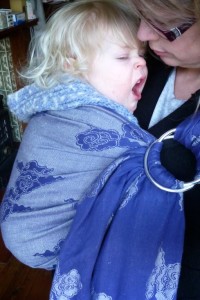
At this point, I remember it well, the relief is enormous. The temptation is very, very strong, to just sit down in a cosy armchair and close your eyes, or a have a little lie down on the bed well propped up with pillows. Soon sleep starts to overwhelm you. Just a a short nap.. a few minutes won't hurt, surely, a chance to recharge my batteries for the next parenting challenge.. sleep is so restorative!
The trouble is, one of the central tenets of safe babywearing is to be aware of your baby at all times.
- The TICKS rules and the ABC guidelines are all aimed at protecting your baby's airway and breathing, and the only way you can monitor this is by being alert.
- It doesn't take long for a baby's breathing to become compromised, and the risk is greatest under four months, when their heads are disproportionately large and heavy and they have not yet developed the cervical stability needed to support themselves.This takes time - the vertebral bodies need to become strong enough to support the head, then the joints, ligaments, muscles, tendons and other soft tissues in the neck need to develop the required strength, and then the back muscles need to be strong enough to pull the heavy head backwards to avoid forwards or sideways slump. This is an active process, and it is easy for a sleeping baby's head to roll forwards onto their chest. This is why head support is so vital, and why a baby's face must be visible at all times.
- This is the same reason why children should not sleep in car seats if possible. We've all seen children with their heads hanging forwards at awkward angles. Studies have shown that this forward lolling of the head can cause desaturation (reduced levels of oxygen in the blood). In contrast, another study has shown that a baby asleep in the optimal upright position with chin up and the head well supported on parent's chest does not show such desaturations. It is safe for a baby to sleep upright in a well fitting and supportive sling if the appropriate guidelines are followed.
- It is also is why bag slings and near-horizontal cradle carries can cause such problems. The enclosing fabric behind the head is dangerous; Babies have heavy heads, more prominent occiputs, and do not yet have the strength to pull their heads up or push against the fabric. The chin ends up resting on their the chest, causing a potential airway compromise.
- It is also why feeding in a sling needs to be undertaken with caution and a good understanding of safety.
- It is why there are so many guidelines about safe sleeping while responsible for a child (whether or not you are using a sling).
A sleeping parent will not be able to check their baby's position often, and correct any breathing difficulties quickly. Grunting or snoring or other unusual noises should always prompt a check on your baby's position and it will be very hard to be aware of such changes while you are almost, or fully asleep.
Your body position will change as your muscles relax in sleep. Your arms may move if you are just holding your baby, and if baby is in a sling, it may no longer remain tight and supportive, possibly allowing him to slump over or curl up into a ball with his chin on his chest, or roll to one side. We've all seen this with babies in car seats. You yourself may roll over as you relax and unwittingly place too much pressure on parts of your baby's body, or encourage him to roll with you.
In short, while you are asleep, you are unaware of what you or your baby are doing. This is why there are so many guidelines about providing a safe sleeping environment for babies, keeping them safe when there is nobody awake.
If you have had something alcoholic to drink, are a smoker, are on medications that could make you drowsy, or have a medical condition that could impair your ability to be aware of your child at all times, you may wish to reconsider how you are caring for your baby when you are tired.
There are of course some ways that a short nap could be done safely with your baby asleep in your arms or in a carrier. For example, if your partner remains in the room with you and alert while you and baby enjoy a rest together, in a slightly-reclined, well supported position that ensures baby is still upright. You may be in hospital with your premature baby and are encouraged to share skin-to-skin contact inside a simple stretchy wrap or boob tube or under a blanket. You and your baby will be very closely monitored throughout if you do nod off in the chair (which often recline at special angles to make it easy for a baby to rest on their tummies, chest to chest with heads well supported.)
If you wish to sleep with your baby close to you, with or without a sling, all the principles for safe co-sleeping apply. The links below explain safe bed-sharing very well.
KellyMom summary - http://kellymom.com/parenting/nighttime/cosleeping/
Mother-Baby Behavioural Sleep Laboratory - http://cosleeping.nd.edu/safe-co-sleeping-guidelines/
BASIS Online - https://www.dur.ac.uk/resources/isis.online/pdfs/ISISPDFbed-sharingJuly2013.pdf
UNICEF Caring For Your Baby at Night http://www.unicef.org.uk/Documents/Baby_Friendly/Leaflets/caringatnight_web.pdf
If you feel at the end of your tether with your unhappy sleepless little baby, this link "How to calm crying infants and get a little more sleep" is an excellent article from Sarah Ockwell-Smith.
Understanding your child's normal sleep habits and modulating your expectations accordingly can be really helpful.
So, is it safe for you to be sleeping while your baby is sleeping in a sling? My answer is, that's your call to make, depending on your circumstances. On the whole, I think the risks vastly outweigh the benefits.
Is it safe for a parent to sleep with their child loose in their arms? Again, my answer is, that's your call to make, depending on your circumstances. On the whole, I think the risks vastly outweigh the benefits.
I would always recommend reading the safe bed-sharing guidelines above to ensure both you and your baby gets the safest night's sleep possible.
Types of Slings
Different slings suit different families at different stages; one type definitely does not fit all. It is like shoes; what fits your friend, or someone on the internet, may not fit you or your baby, choosing a sling is best done by trying things out!
Here is an introduction to each of the major types of sling, which will help you to assess which might suit your baby and your lifestyle best, and how to use it. Remember it can take a little practice for you both to get used to a carrier.
Welcome to Slings
Welcome to the wonderful world of slings! You may be new to carrying and a bit overwhelmed about the choices available. You may be just starting out with your carrier and not sure if it’s the best or most comfortable option and wonder what else there may be. Read on for more information about how to make babywearing work for you, your baby and your family.
“Using a carrier does not mark you out as a particular type of parent, who subscribes to particular cultural beliefs; it simply means that you are choosing to keep your child close, according to your biological instinct and their biological needs, making life work in the best way that you can.” – Dr Rosie Knowles, Why Babywearing Matters
New to slings?
Not sure where to start when it comes to using a sling? This is a common concern among parents who have become convinced of the benefits of carrying their baby but feel a bit all at sea about the huge variety of slings and the confusing jargon in the sling community.
- There are many positive effects of using a sling with a very young baby; there is much evidence to suggest that skin to skin contact between mother and newborn (especially premature) babies can confer great advantages on both. The baby gains assistance with their physiological regulation of breathing and heart rate, temperature control is improved, and the contact helps to establish breastfeeding and promote more rapid growth compared to babies who are not held as close for as long. Furthermore, the baby will feel more secure in his developing relationship with his caregiver, due to the time spent in close contact.
- The caregiver enjoys positive effects too; he/she may find themselves more able to bond with their baby, due to the increased release of oxytocin, and post-natal depression may be reduced. Being able to be “hands-free” can really make a difference to a family’s ability to get around with their new baby, keeping them active and engaging with normal life.
- There are also many positive effects for society; such as a reduced burden of mental health and greater fitness.
Firstly, make sure you choose a sling that allows you to carry safely.
This is especially important with young babies who are still small and in need of “fourth trimester” nurturing. In summary, a baby’s airway should be supported with the head well aligned with the spine, thereby avoiding curled-up into ball positions that could impair breathing. Carriers must not be too tall, do not be tempted to tuck your baby’s head down inside a carrier for “head support”.
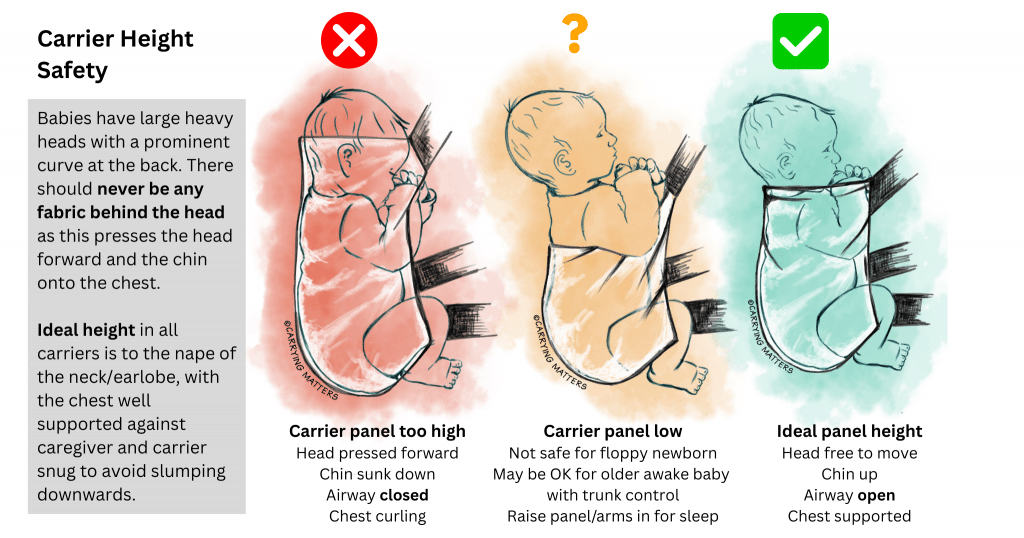
Ergonomic slings will respect this and carry a baby in a seated position, with the knees above the bottom. By bringing knees up, babies’ hips are rotated and do not need to be spread very wide to be resting comfortably, as the image shows. Narrow-based carriers (sold by high-street shops and online) are not always unsafe, but they are often suboptimal and may not be as comfortable for a baby to rest in as one that has a wider seat and encourages the knees to be raised.
Such hip-healthy positioning also helps to stabilise a baby’s back and protects the airway, as it reduces the amount of backward head lolling and uncomfortable straightening of a baby’s curved spine.
Click the link to read more about safe positioning in a sling and click here for information about healthy hip positioning.
This baby has just had her stretchy wrap removed; the sling has held her in the natural "in- arms" position

Safe, anatomically correct and comfortable positioning in arms and in a carrier
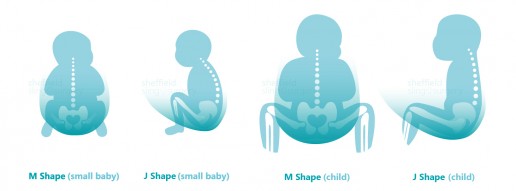
Secondly, choose a sling that is comfortable
Many parents find their high-street carriers can be less comfortable than they hoped, especially as their baby grows, and may stop using a sling at all.
Good slings have been designed to mimic in-arms comfortable carrying as much as possible, and many people find they are able to enjoy long walks with their children, up to pre-school age, with such an ergonomic carrier.
Broad weight distribution across the parent’s body matters; a child who is able to snuggle in and shift their weight closer to their parent’s centre of gravity will feel a lot lighter than one who is held in a stiff pocket, or held lower down and facing out (thus pulling away from the parent).
This applies in front, hip and back carries equally. Positioning makes a great deal of difference to your child’s and your experience of the sling, and is the most important factor in how comfortable it is.
You can make your high street carrier more comfortable in a variety of ways, for example by ensuring your baby is higher up on your chest, held snugly, and using a scarf to redistribute the weight. Your baby should be held snugly enough not to swing free when you lean forwards.
Features like the type of shoulder strap (wide or narrow, those that cross over on the back versus those that are more like rucksack straps), the shape and sturdiness of the waistband, and the type of fabric used can also make a considerable difference. It is always worth trying before you buy, and there are many sling libraries around the country that can help you do this. The Sling Pages has a full list for you to check your local resources.
"Scarf hack" for narrow based carriers
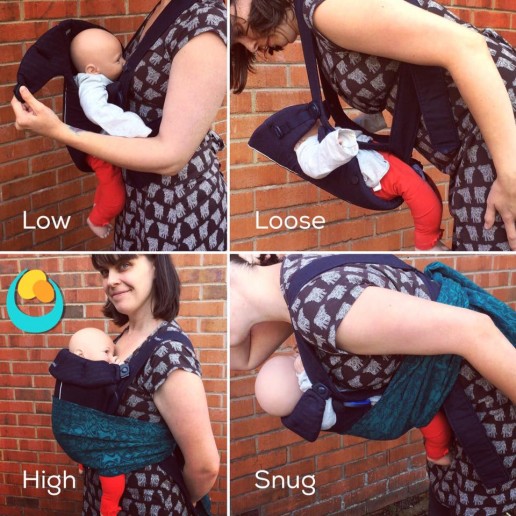
Thirdly, think about what kind of sling may suit you and your family best
Stretchy Wrap
If you have a newborn or a baby under six months, most people will start with a stretchy wrap. This is usually a long piece of jersey style elastic fabric that is between 4 and 5 metres long, and can be wrapped around your body to create a snug pocket your baby can nestle into. Depending on the quality of the fabric, the stretchy wrap is usually used up to six months. It is often worth investing a little more for higher quality.
One size (usually) fits all, and it can be tied on and left on all day for convenience, popping baby in and out with ease without needing to take the sling off each time, many parents don’t realise this. It is possible to use the stretchy wrap as a breastfeeding aid, with care and attention to baby’s airway.
You can read more about stretchy wraps here, including how to use it well.
Close Caboo Carrier
This is a slightly more structured and less stretchy variant of a stretchy wrap, with a little less flexibility. It is put on, adjusted carefully, and then baby is popped into each of the cross passes on the front. The fabric can be tightened through the rings to achieve a snug fit. The Close Carrier can be used as a breastfeeding aid if required, with care and attention to baby’s airway, and most people will find it supportive up to three to four months.
Ring Slings
This is a piece of woven fabric which has one end sewn securely into two strong rings. They are worn cuppring one shoulder with the child sitting in a pouch on the opposite side of the parent’s body, with the loose end of the fabric threaded through the rings in such a way that the tension holds the fabric firmly and the weight is distributed across the shoulder and back.
They have the advantage of being lightweight and (once the knack is gained), quick to put on and take off. They can be very useful for those who need to be able to carry their child on the hip, or need something that offers the child a good viewpoint in all directions.
Ring slings made of woven fabric and with no padded rails are usually the best option, and shoulder style (pleated or gathered) is a very personal choice. They can be used from birth to toddlerhood, and it can be easy to breastfeed in a ring sling, with the appropriate attention paid to airway and positioning.
Hip carriers
Pouches are another kind of hip carrier which can be very simple, but need to be fitted to size; they can be a risk for babies under 3months if used badly.
The Scootababy is a buckled hip carrier with a waistband which can be used from approximately four months and up into toddlerhood.
Carrying aids and hip seats can make hip carrying easier but are not hands-free.
You can read more about ring slings and hip carriers here and your local sling library will be able to help too.
Woven Wraps
Woven wraps are excellent choices if you want great comfort and longevity. They can be used from birth to toddlerhood and beyond. Woven wraps are long parallelogram shaped pieces of fabric, anything from 2 to 7m long.
They are woven in a particular way to provide gentle all-around pressure, supportive but still soft and mouldable. Most woven wraps are made of cotton, some may contain other fibres such as linen or hemp, for extra support, and come in many different colours and designs.
Many women around the world use local woven cloths for many purposes as well as for child-carrying. These cloths and woven wraps feel very different from the fabrics you might find in a haberdashery shop; these are more likely to fray and tear.
Many people begin with a 4.6m wrap (known as a size 6) and learn a carry known as the Front Wrap Cross Carry. They can take a little practice but they allow a great degree of adjustability and weight distribution around the body. There are numerous ways to tie the same wrap, so they can be used on the front, hip or back at the appropriate ages. Your local sling and carrier consultant or sling library will be able to get you started!
Upright breastfeeding is possible, if done safely with the appropriate attention paid to airway protection.
You can read more about woven wraps here.
Meh Dai/Bei Dai (formerly known as Mei Tai) Carriers and variants (half buckles, onbuhimos, etc)
These are Asian inspired carriers made of soft fabric, and are popular with those who appreciate the mouldability and support of woven wraps but need something with more structure, or speed of use.
They consist of a fabric panel that has two straps at the base which are tied or buckled securely around the waist, and two straps from the top of the panel which can be wrapped around the parent and baby to ensure a snug and comfortable fit. Baby sits in the pouch created by the panel, and the long straps allow a great degree of adjustability to all shapes and sizes. They can be worn on the front, hip and back at the appropriate ages, and upright breastfeeding is often possible, if done safely with the relevant attention paid to airway protection.
Your local sling library should have a few of these to try out.
You can read more about meh dais and their variants here.
Full Buckle Carriers
If you’re not sure about tying fabric, a good option is a full buckle carrier, which has a buckle on the waistband, and the shoulder straps buckle into the panel at the sides. Baby is seated facing the parent, inside a supportive pouch that supports them widely across the base from one knee to the other.
Waistband types vary, from the minimal to the heavily padded, and people’s preferences vary enormously. Some shoulder straps cross over on the back when baby is on the front, others are fixed into a rucksack style. The shape of adult and baby together is very individual, as is the health of the adult’s back, so what suits one pairing will not suit another. More padding does not automatically mean “better” or more comfortable, and those with back pain will not always need heavily structured slings. Good posture and general back health are important – read more about this here.
Buckle carriers can be very quick and simple to use. Often, a little practice to get the straps and positioning optimally adjusted is well worth it. Most good full buckles fit well from three months upwards; some can be adapted for younger babies by rolling the panel or by using inserts to keep baby snug, high up and visible. Many carriers will last into early toddlerhood, and some beyond that, depending on design.
Many mums find that breastfeeding in the buckle carrier is possible, if done safely with the relevant attention paid to airway protection. Most can be used on the back once babies have grown.
Some buckle carriers will allow baby to face the world. This can be great, when done safely and responsively. It is recommended only from four months upwards, not for sleeping in to protect the airway, and only for short periods of time. This is due to the reduced opportunity baby has to see and interact with his parent and learn about the world based on his parent’s response to it – this is known as social referencing. There is also reduced hip and leg support from the narrow base which can be an issue in some circumstances, as well as less comfortable for child and parent. Carriers that provide hip healthy positions facing out are generally preferred. (read more about facing out here.)
You can read more about buckle carriers here.
Fifthly, enjoy your sling and let the world see it!
Why not share your enjoyment with the parents you meet so they can discover slings too? We all carry our babies, some in arms, some in high street carriers, some in wraps, some in ring slings, some in meh dais, some in buckles. We all learn from each other; encouragement is always more productive than criticism!
Here is a lovely article from Ellie at Peekaboo Slings about the importance of no judgment; “We want to normalise babywearing and promote carrying your children close – put bluntly, we don’t care about the rest”.
Fourthly, be aware of the changing needs of your baby
The weather conditions may change how you carry your baby; being aware of the heat and the sun, or the cold and the rain may affect your choice of sling and your clothing.
As your baby grows, her own needs will change. She may want to sleep less and look around more. She may prefer hip carries, or even back carries, so she can see into the world into which she is being carried. As she gets heavier, the carrier you began with may begin to feel less supportive for you and for her; for many this marks a move towards “toddler-worthy” carriers. This may be different ways of tying your woven wrap, learning how to adjust the straps on your meh dai to ensure knee to knee support, or moving up to a bigger, toddler-sized (or even preschooler!) carrier when you need to. Your “baby” sized carrier will often last a lot longer than you think.
You will not spoil your baby or make him clingy by carrying him as he grows. Big kids need cuddles too – loving contact is vital to our emotional health and security, from cradle to grave. You can read more about carrying older children here, and your local sling library or consultant should be able to help you make the most of your carrier.
How to Choose a Sling
I have met thousands of parents over the years, wanting help with choosing a sling. It’s fantastic to support them in their desire to carry their child close, with all the great things this will bring the whole family. For many, they can feel utterly overwhelmed by the huge range of options on offer (see here for a quick introduction to carrying, and here for a quick overview of the major types of sling).
Very often, they will ask me what I would recommend.. and this is a very hard question to answer, one that I usually respond to with more questions! Everyone’s choice of carrier is unique for themselves; and their initial choice will often change as they try things out.
Initially, when it comes to choosing a sling,
many people will look for a carrier that isn’t especially expensive, to see “if they get on with carrying.” Others will pick something that has been marketed by a mass-manufacturer in mainstream stores or at trade shows as being the best option available or will have picked something recommended on social media (please be aware of the fact that many of these influencers have no idea how to use a carrier well or safely), or will choose something for the specific features listed, such as the ability to carry a baby in multiple positions, or being described as “the best”. Some may have been given carriers by their friends from several years ago (often hardly used “as it just didn’t work for us”), or bagged some ultra-cheap ones on Ebay/Vinted.
This can sometimes lead to problems, as such carriers may not have been specifically designed to work with parent and child anatomy and can thus often be uncomfortable after only a short time. They may be worn too loose or baby may be too low, causing back pain from the strain of the carrying or the hunching that can ensue (as well as potentially posing an airway risk – also see here for more about carriers being too big). This can lead to a belief that that baby is too heavy or that the parent isn’t strong enough (neither is usually true!) and carrying journeys come to a premature end. At this point, those who want to make carrying work for them will often look for support from someone like me to find something that works. Of course, some parents will come straight to us right at the start!
A good carrier should be comfortable for both baby and parent. It should support baby safely, protecting their airway and allowing easy breathing, in just the same way as when you hold them upright on your chest in your arms.
A good carrier should hold baby in the anatomically appropriate spread-squat position that respects infant and child spine physiology, and it should be snug against parent/caregivers chest for weight distribution. Carrying in this fashion is safe, and is usually much more comfortable and allows longer duration of sling use than in-arms or in a poorly fitting carrier. (Do remember to build up your carrying muscles day by day. It is exercise and gets easier with repetition, just like training for a race.)
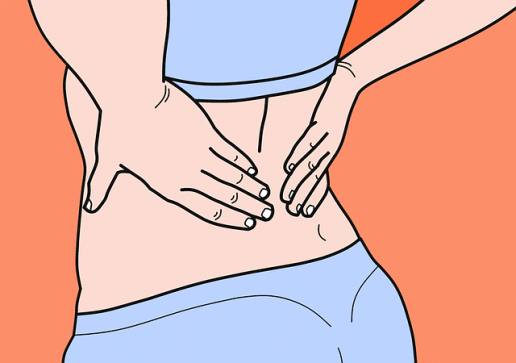


People end up choosing their main carrier for many different reasons – and each individual will have different priorities, which will lead to their own personal choice. When I am asked what I would recommend myself, I often describe a bar chart like the one below, which shows just how variable things can be, and what suits me won’t suit them. Some people will prioritise comfort and longevity over pricing and simplicity; some value customisability and appearance more than pricing or resale value, everyone is different. People may end up choosing alternative carriers that they had originally envisaged, based on their “list of requirements”, due to how the sling feels for baby and parent when it is fitted.
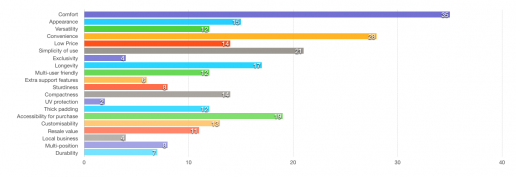
This is why one “size does not fit all” and why many of us in the sling world use an analogy of shoe fitting, jeans or wedding dresses when it comes to trying a carrier. Everyone ends up with something difference. Cheap shoes bought over the internet often don’t fit your feet and can cause blisters. Jimmy Choos, Louboutins or Doc Martens really do not work for everyone, however desirable or pretty or cool they may be. What works for your friend, or for a large number of enthusiastic sling owners on the internet, or an experienced sling professional may not work for you. Current trends or famous brands don’t equate to an instant “perfect fit” and no one carrier can claim to be “the ultimate” or “the best.”
Trying a few things out before you commit yourself to a purchase that can feel expensive is very useful, and it is often worth spending more on a good quality carrier that fits you well, to ensure you and your baby are both comfortable and that it will last for some time. Many people find, however, once they have the right sling, it gets used daily, and the cost per use per day comes down to pence. Don’t be tempted to buy an extremely cheap carrier that may well be a fake (Ergobaby is the best known carrier to have been counterfeited) – always ask for proof of purchase from an authorised retailer when buying second hand. Your child’s safety isn’t worth the risk. Buyer beware!
Once you’ve recognised the benefits of carrying as comfortably as possible, how do you begin to choose?
I highly recommend visiting your local sling library to try out several options; there will be someone there with training and experience to help you navigate the choices. Some people will have a “shopping list” of requirements for their ideal carrier, based on what they have read online or been advocated by a friend or an internet group. Of course, such recommendations can be helpful, but a one-size-fits-all approach rarely works in practice. Every baby-parent dyad is unique, with their own personal stories that influence how they stand, how they carry, how they prefer to be held, for example, and particular features that seemed desirable on paper may not feel quite right in person. If you think your other half is likely to carry too, do bring them along to try things themselves; it is very hard to guess what will work.
For example, some people will love the feel of thicker, more padded waistbands, while others will find them bulky and restrictive. Some will prefer straps that cross over, others find this can ride up to the neck. Some find rucksack style straps hard to do up. Some inserts are simple to use, others more complex, many don’t like inserts at all. Some people find meh dais and woven wraps more comfortable than carriers. It is generally a good idea to have an open mind; you may be surprised to find some things work much better than you had imagined, while others just don’t feel quite right.
Bulky carriers may not necessarily equal greater support or comfort for everyone, and too much bulk can be unhelpful for some. Knowing how to achieve good positioning and how high and tight to have a carrier are very effective tools for successfully distributing weight comfortably.
A good sling librarian or peer supporter will be able to show you how to position your child, as well as tips and tricks that can make things much easier (such as how to put on fiddly straps, or how to make sure your stretchy wrap is tight enough, or how to ensure your ring sling feels secure). Sling libraries are fantastic resources.
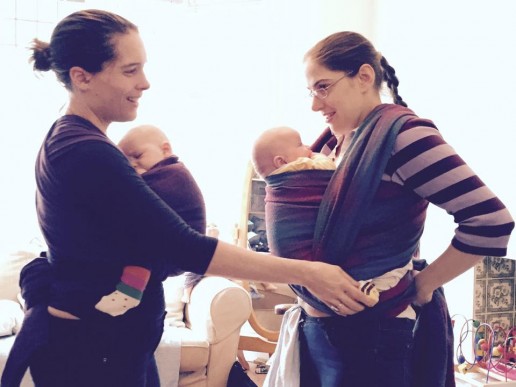
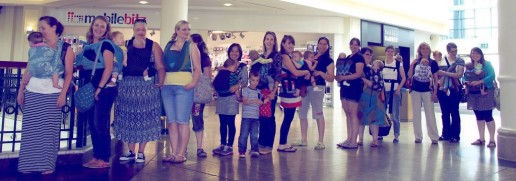
It is worth being aware that knowledge about sling safety and best practice positioning is improving all the time. Older carriers and older brands may have instructions that are no longer part of current safety guidelines; social media is often marketing focused and wildly inaccurate, feeding and sleeping positions in slings are often out of date. Do check with your local sling professional if you have any concerns at all, they will be only too pleased to support you and your child.
Your sling should bring you and your child great enjoyment and should not cause you pain or be uncomfortable. Furthermore, as a family’s familiarity with slings grows and as their baby gets bigger, their choices can change. They may move from things that are especially designed for small babies, or carriers that are as simple as can be, on to things that they find increasingly versatile and comfortable. Babies may wish to change how they are carried, desiring greater visibility, for example. Each parent may have different shapes too, and families may decide to have different carriers for different situations (eg a simple buckled carrier for use on a school run or on a muddy day, or a woven wrap for a long sleep-inducing walk, for example). There are no “perfect” answers, but options that end up being the best choice for the circumstances.
Sling Safety Matters - How to Use a Sling Safely
Sling safety matters. Carrying our children in a sling safely can be one of the most precious experiences we ever have as parents or caregivers. There really is something very special about the bond that builds from keeping your child close.
However fantastic it may be, it must be done safely, for your baby’s health and your own. As parents of small babies and bigger ones, one of our greatest priorities is to keep our children safe. A good, correctly fitting sling can be a very helpful tool for this; keeping a child safe while daily life continues.
Four key areas to watch – see more detail of this image at the link here
Sling use for very young babies (birth to four months)
This is becoming increasingly popular around the more developed world; a practice that has in fact been universal for thousands of years. Families that live in extended communities or “villages” are usually able to share well-honed, tried and tested knowledge down the generations and provide easily accessible advice and support. This kind of local support is much harder to come by in our more fragmented societies, which means we often turn to books or the internet to fill the gaps in our knowledge and provide us with reassurance we are doing it right. Unfortunately, sometimes these sources of information are out-of-date, incorrect or even dangerous, and can lead to problems with the use of any kind of baby equipment. Manufacturer instructions can be slow to be updated with new “best-practice” guidelines and YouTube videos not made by professionals can often be misleading and miss out important information.
Many carriers on the market hold babies very low down and loose, which will allow young bodies with little muscle tone (especially during sleep) to slump and end up with nose and mouth pressed against fabric. This is an airway risk. They often talk about “head support” but use rigid high backed panels that tip baby’s large head and chin forwards onto their chest. This is not wise or responsible. Read more here.

Why bother with a sling at all if there are any risks?
There are many benefits to using a sling with a very young baby; in fact. many hospitals use them in the practice known as “Kangaroo Care”, and there is much evidence to suggest this skin to skin contact between mother and newborn (especially premature babies) can confer great benefits to both.
The baby gains assistance with their physiological regulation of breathing and heart rates, temperature control is improved, and the contact helps to establish breastfeeding and promote more rapid growth compared to babies who are not held as close for as long. Furthermore, the baby will feel more secure in their developing relationship with his caregiver, due to the time spent in close contact.
The caregiver may find that he/she is able to bond with her baby, due to the increased release of oxytocin, and post-natal depression may be reduced. Being able to be “hands-free” can really make a difference to a family’s ability to get around with their new baby, keeping them active and engaging with normal life.
The key is to know how to use the sling in a safe and secure way, just as you may practise learning to ride a bicycle, or drive a car. Familiarity and practice make perfect. All baby equipment should be used safely, and it is an unfortunate fact that sometimes things are not fit for purpose, or the instructions that come with equipment are inadequate. Babies should be able to breathe easily, be at a comfortable temperature, and held in positions that are healthy and beneficial for them.
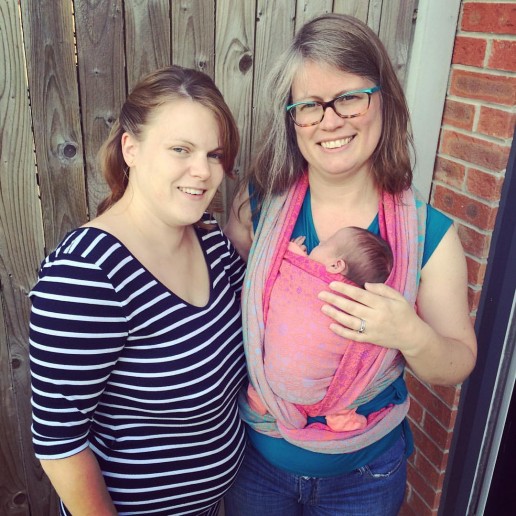
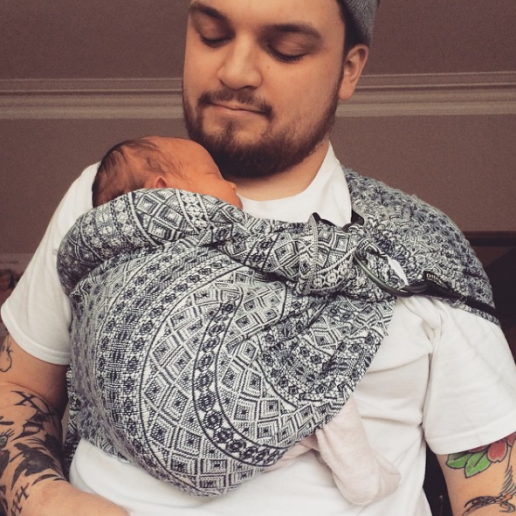
How can I ensure I am using my sling safely?
A good sling should mimic the natural, in-arms upright position for carrying babies, ensuring the caregiver can see and sense the baby at all times, and thus able to be quickly aware of and rapidly responsive to any changes.
I see a lot of parents with newborn babies wanting to learn how to use a sling, and the photos and the position diagrams here are the first thing we look at.
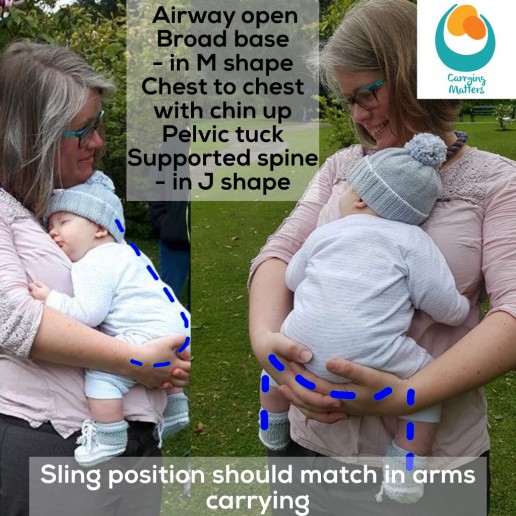
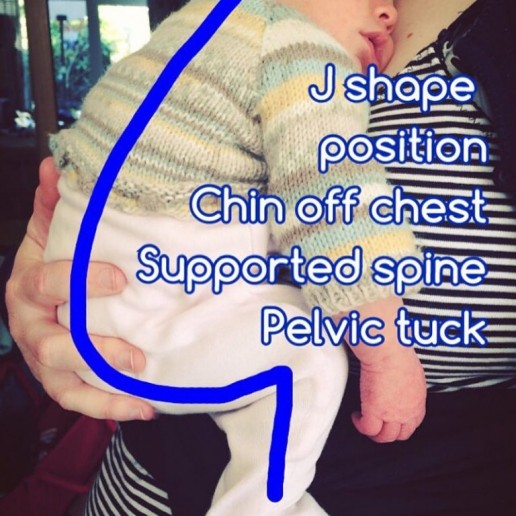
Babies grow in tucked positions, and after birth, they tend to maintain this gentle curve to their spines for several months due their lack of muscle tone or strength to their head and neck and upper torso. It is not till they are older that they have the strength to hold their spine in a straightened posture. It is not till they can crawl and stand and are beginning to walk that their muscles and ligaments hold the spine in the more adult S shape. While babies are young, holding them in their naturally adopted tucked positions is both comfortable for them and also more comfortable for you. If their backs are well supported, their heads do not need rigid support, do not be tempted to raise head rests or sink babies down inside panels. Babies will rapidly develop head control – here is some guidance about managing a “floppy head” without compromising airway. As they grow and begin to develop their strength and clinging ability, their needs will change.
Young babies who are seated in the “squat” position or the M shape (looks like a J shape from the side) will have a broader, more stable base to rest on than a narrow perch. This position, with the curve mainly at the base also helps to keep the chest flat against the parent’s body and thus in an expanded position for good airflow.
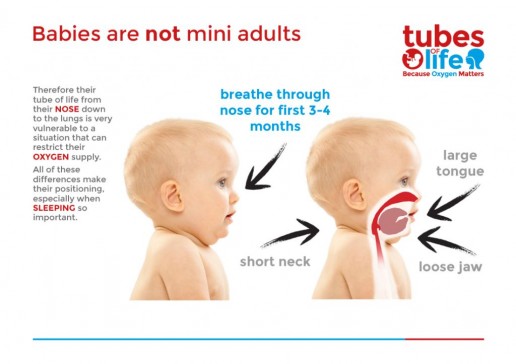

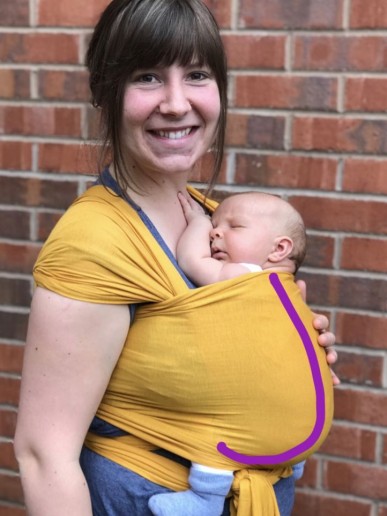
Babies under 3 to 4 months are most at risk of airway compromise when chin can sink onto their chests; so a good carrier will hold baby’s chest snugly against yours to keep the chest cavity uncurled and the chin off the chest. It is important to ensure no slumping and that there is no fabric over the face and there is a good air supply. Babies have a disproportionately large occiput (the back of the skull) and a short neck, along with lower muscle strength and co-ordination compared to adults. Rigid surfaces behind the back of their heads tend to push the skull forwards so chin sinks onto chest and can obstruct airway. This is is why upper back and neck support (no further up than the earlobes) is so important, rather than using headrests which can be risky.
Stabilising a child’s body with a broad base and good upper back and neck support is key in the early months.
This also applies to car seat usage; rigid shells with a hard back holding babies at 40 degree angles can also push a baby’s chin onto their chest and is why it is not recommended for newborns to sleep for long periods in car seats.
Babies should be dressed appropriately to ensure they do not get too warm; people are often surprised how quickly everyone can warm up when in close contact. Please do not use thick, furry or padded snowsuits and dress down. You can always add more layers over the top.
Respectful, anatomically appropriate positioning
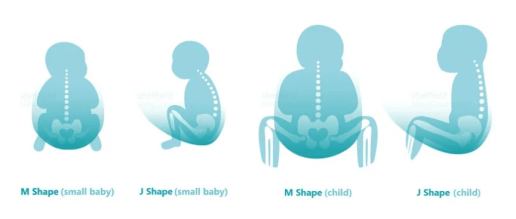
ABC is the basic first-aid mnemonic, which can be adapted for safe sling use.
AIRWAY is vital. Babies’ heads are heavy and it takes time for their muscle strength and tone to develop enough to hold up their heads and support their own airways; until then, it is our job as parents to be as caring and careful as we can. A baby’s head should be resting against the caregiver’s chest, with the windpipe straight, not curled over. A good guide is at least two fingers being able to fit between baby’s chin and his chest. Air should be able to circulate freely and the face should not be obscured by fabric, or buried within cleavage. Baby’s cheek can rest against parent’s chest, and hands should be accessible to the mouth for sucking if needed (and not trapped down the side of the sling)
BODY POSITION is important to protect the airway as well. The upper body should be supported against parent’s chest, to ensure no slumping (this is why carriers should be tight, to make sure that babies do not roll up into a ball). The pelvic tuck into the M shape with knees higher than bottom will help support baby’s back as well as being very comfortable. The neck should be supported where possible to avoid backwards lolling but the back of the head should never be tilted forwards (see the image above – babies have a larger occiput, shorter neck and less-strong neck muscles than adults). The pelvic tilt and using a rolled muslin cushion (to rest below the earlobes) can be helpful if babies resist head support. See the diagrams above for the correct shaping.
COMFORT comes last – I would rather see a child in an uncomfortable carrier that was safe, than fast asleep slumped into a tight ball or folded over in a cradle carry, however comfortable it is. However, you and your child are likely to enjoy and appreciate a carrier that is pleasant to use, fits well and does not cause back pain. Here is some advice about how to choose a carrier. Comfort also covers the baby’s temperature; too hot is a problem, so please layer your baby carefully and do not over-dress them.
In summary, the safest position is an upright one that meets the TICKS guidelines – Tight, In View, Close enough to Kiss, Keep Chin off the Chest, Supported Back.
I would never recommend any kind of lying- down position in a carrier, especially where the back of the head is bent forwards to compress the airway and a child is thus not able move its head freely to clear any blockage. Bag slings, ill-fitting pouch slings and other slings used badly can be risky.
Breastfeeding is usually safest done in upright positions for this reason, and a child who falls asleep feeding in a sling should always, always be brought back into this safe upright position, to protect the airway. Babies should never be left to sleep in a cradled position inside a sling; this can be dangerous.
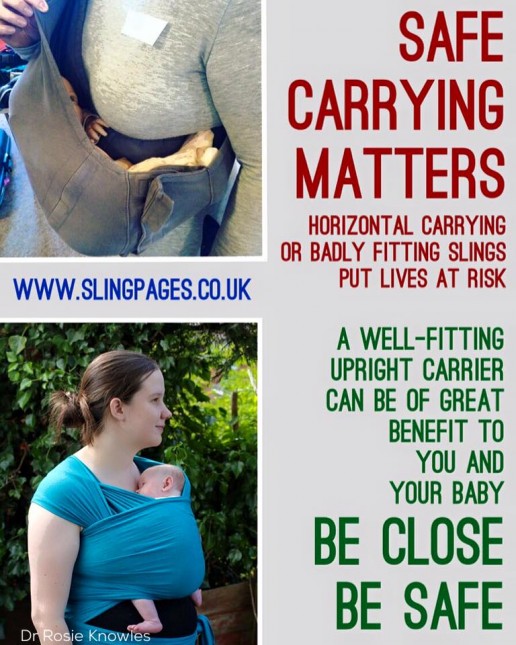
What about older babies beyond the early weeks and months when they are developing more control over their bodies?
As babies grow, their needs and abilities change. A baby who can maintain their own airway independently will expect more freedom and will show you this with wriggling and turning. Their wild jerky movements are how they practice muscle control and learn coordination. Movement is important, babies should be given the opportunity to explore their bodies whenever possible. Parents and carers will need to find a happy balance between the need for safe and comfortable transportation, a place to sleep or feed, and their baby’s need to move. It’s worth being aware that prolonged, unchanged positioning isn’t good for anyone and even adults are being encouraged to move every 45 minutes. Children’s bodies are still growing!
Try to change positions, try in arms carrying, swap with other carers, use a buggy, to give children a variety of experiences and positions.
Top Tips
Position matters
- Your child must be able to breathe safely in the sling. Their chin should not be touching their chest (a good guide is a space two finger-widths or more) or lolling back too far. (Try it yourself! Can you swallow your saliva with your chin too close to your chest or lolling all the way back?)
- To ensure no slumping, position your child correctly against your body, chest well against yours, and bring the carrier over your baby as you hold them. This video will help you to ensure no slump.
- A child whose bottom and legs are well supported from knee to knee in a “spread squat” or “M position” is in a more stable position and will be less likely to fold up or slump over.
Know your sling and know your baby
- Always familiarise yourself with your carrier before you use it for the first time. Ensure you have a good idea how to use it. Some people like to practice with a teddy bear near a bed and with a mirror to see what is happening.
- Always check your carrier before use for any wear and tear, that all component parts are present and fit for purpose (eg is the chest belt in place? Are any buckles in the right places and not broken, are the seams are intact?)
- Check your baby is willing to be carried. The only “unsafe” carry is one with an unwilling baby. If baby seems unkeen, can you establish why? For example, is he hungry? Is she wet or dirty? Does he have reflux or does he find certain positions uncomfortable? Does she want to do something else? Is he too hot or cold? Is she in pain? If he or she cries in a sling, read here about some of the many other reasons a baby may express distress.
Dress appropriately
- Ensure appropriate clothing – the sling may add additional warmth, so layering is a good idea.
- In cold weather there is a temptation to wrap up extra warm but this needs to be done with care. Too-warm babies are less likely to wake if their breathing slows. Don't be tempted to over-dress!! You can always add more layers over the top if babies really are cold.
- Many people find baby leggings, gloves on strings, well fitting hats and tie-on warm booties to be especially helpful in the chill. Thin layering is key.
- Read more about the risks of snowsuits here.
- Don’t forget to ensure your baby doesn’t get too hot in the summer; protect your baby from sunburn and to keep well hydrated in warm weather.
- An useful tip, if you dress your baby in a bodysuit with feet, is to choose a larger size than for ordinary wear, as the fabric will ride up a little with the sling and may squash tiny toes.
Be alert at all times
- It is important to be aware of your child at all times; if you feel something is different, check! Some people like to carry a small pocket mirror so they can check on children riding on the back.
- It is wise to consider what physical activity you wish to do while babywearing; will it hinder your awareness of your child in the sling or hamper your ability to deal with any problems? Your baby will be at a height in the sling and may be able to reach for unexpected items – awareness and attention is vital.
- Be very cautious when engaging in any form of exercise or dance with your baby in the carrier; many manufacturers do not recommend this, and there are risks with young babies and untrained class leaders. Read more about slings and exercise here.
- Your sling is NOT a substitute for a car seat, and you should not sleep while carrying your baby.
- Do not carry your baby facing out in a carrier before 3-4months, and avoid letting them sleep facing out. Be responsive to their needs and turn them back to face you when showing signs of weariness. Choose a carrier that will be comfortable for their spines.
Get help and support
There are many, many sling communities in the UK, sling consultants like myself who offer one to one sessions where you can look through the options and practice using a carrier safely, sling libraries with trained peer supporters where you can try out slings and get some advice, and sociable sling meets that will serve a “village” purpose for parents to share their growing knowledge/personal journeys and offer support. Don’t rely on books/pamphlets/the internet – be armed with education and take advantage of the experience you will find in your local resources.
If you are unsure, do find your local sling professional at the Sling Pages – we are always happy to help.
Breast and Bottle Feeding Safely in a Sling
Carrying babies is a wonderful way to encourage successful and more long-lasting breastfeeding, as the frequent skin to skin contact and the building of loving relationships help to stimulate oxytocin release.
Oxytocin release (which stimulates let-down) becomes conditioned to the mother’s experience and emotions; the touch, sight, smell or cry of her baby, as well as thoughts of her baby and the natural rhythm and expectation that baby will be hungry soon.
A sling that allows ease of access to the breast encourages responsive feeding, helping the harmonious nurturing relationship to flourish.
Mothers can go about their daily tasks or care for older children while their child’s need for nurture and nourishment can continue uninterrupted. This is normal human behaviour.
If the mother is in distress, unwell, or struggling with postnatal depression or anxiety, her feelings will inhibit oxytocin release and have an impact on breastfeeding. Close physical contact with her child as well as effective emotional support can help a feeding relationship to recover.
A comfortable baby carrier can thus be an excellent solution for a breastfeeding mother and baby who have had a complex start. This can be especially valuable after a difficult labour and birth or a prolonged separation for medical reasons.
The carrier can help create a safe space for the dyad, keeping them close together, allowing them to heal each other, encouraging the hormones of love and bonding to flow. This has a positive impact on breastfeeding.
If breastfeeding comes to an end, the baby carrier can preserve the growing relationship by keeping mother and baby in close contact and help it to continue to blossom.
There is always more of a risk to safety when combining breastfeeding with babywearing and it must be done well. Here’s my guide to safe breast and bottle feeding in a sling!
I meet a lot of pregnant ladies in the course of my varied roles, and many new mums, and one of the questions I am most frequently asked is “Will I be able to feed my baby in a sling?”
It’s an important question to deal with, as it crops up so regularly, and for some, is one of the criteria for choosing the right sling for their needs. The simplest answer is that, “Yes, many parents are able to feed their babies in slings, from the breast or from the bottle.”
But this then leads to other vital questions…
1. “Why might you want to be able to feed in a sling?”
2. “How can you keep your baby safe while feeding?”
3. “How can you make feeding in a sling as easy as possible?”
4. “What slings can be helpful for feeding?”
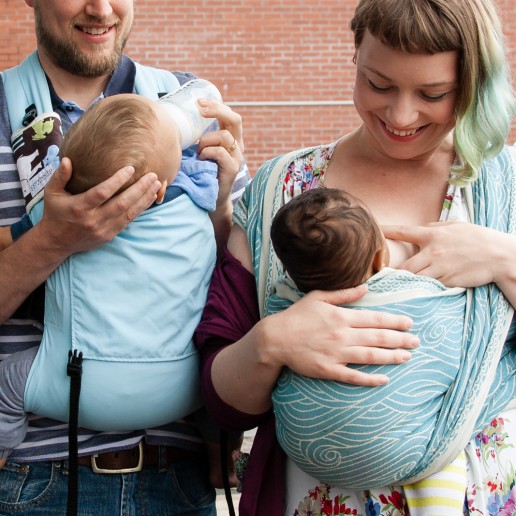
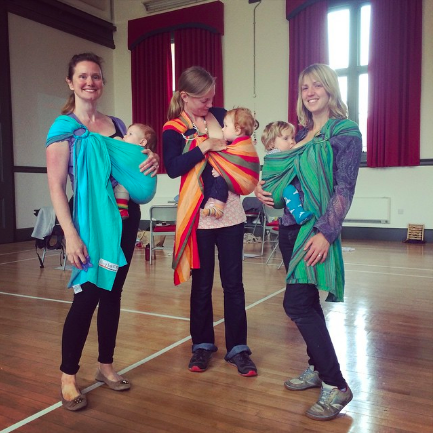
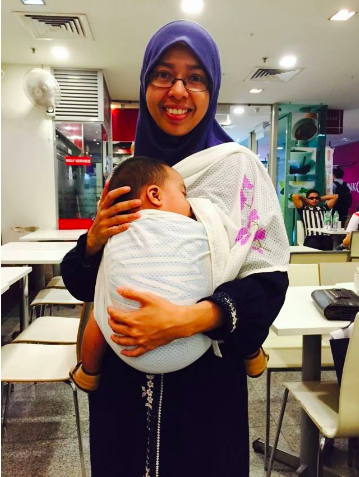
1) Why might you want to feed in a sling?
Most commonly, mums of more than one child find being able to feed the baby on the go very useful. This is especially so if they are feeding responsively, as recommended by the WHO, and have an older child who needs their parent just as much. Quite often, they will have had some experience of breast or bottle feeding already, and may be very familiar with their sling, and will be “old hands” at combining the two skills.
Mums of older children who can feed quickly in a sitting upright position may also find a sling an invaluable and very convenient tool for getting on with daily life.
For mums of small babies, it may be that the sling will be useful to carry their child to a place where they can be taken out to feed in peace and comfort. For others, being able to have baby partly supported with the sling and with one arm may allow a “third hand” to work on achieving latch, and can prove very useful for facilitating feeding. For others and once feeding is established, it can allow some simple multi-tasking rather than being pinned to the sofa.
On the whole, it may help to consider each element as a separate skill to master – how to feed, and how to use the sling, and learn how to combine them safely, however, for some, the sling can actually be an aid to achieving latch. Practice will, of course, be needed, like with every new accomplishment!
2) How can you keep your baby safe while feeding?
All the basic rules of sling safety apply when carrying a baby. The TICKS guidelines and the ABC reminders are below. However, there are different considerations needed with feeding in slings (as baby may not be close enough to kiss, for example). As always, protecting the airway and ensuring breathing is unobstructed is of paramount importance.
Babies are not mini-adults and are not able to breathe easily through their mouths for the first few months of their lives. They breathe mostly through their noses (allowing them to breathe while feeding), so unobstructed nasal airways are really important. This is why babies may struggle more than older children with mild respiratory infections affecting the small nasal passages, and explains why simple colds and respiratory viruses (eg RSV) can have serious impacts on newborns, as can any sinking of the chin onto the chest, closing the airway. Increased vigilance is needed during sleep, as muscle tone relaxes further. Feeding of any type in the carrier must be done with great caution as babies can slip into sleep as they finish their feed and airway can become obstructed. This is why we are always so careful to mention no fabric behind the head at any time, a fact often missed by carrier companies who focus on “head and neck support”.
Therefore, while a baby’s mouth is engaged with the process of sucking and swallowing, his only patent airway is his nose. It is important for the carer to be consciously aware of any potential obstruction, either external (from sling fabric, or breast tissue, or clothing ) or internal (neck bent over too far) and able to rectify it rapidly when required.
Whether feeding upright, or slightly reclined, the safest positions are…
-
those in which the parent is actively engaged and frequently checking on their child, and able to recognise any changes
-
those that ensure a good air supply at all times with no fabric over the head and chin off the chest (check you can fit two fingers underneath if you are unsure)
-
those in which baby’s head is aligned with their spine and only turned slightly to one side if needed
-
those in which baby’s back and occiput (lower part of the back of the head) are appropriately supported
-
those in which baby’s knees are above the bottom and hips are flexed (bent upwards)
-
those that ensure that a baby who has finished feeding or has fallen asleep is returned to the most optimal upright position to keep airway supported and open.
The choice of best position will vary from person to person, depending on the individual circumstances, however, the majority of successful “on-the-go” feeding is done in the upright position.
In my opinion, the greatest risk comes from breastfeeding in positions where baby is held face inwards towards the breast, with sling fabric pulled up over the back of the head, so the face is pressed firmly into breast tissue or the child is curled over into a ball.
Please note this dangerous position is not the same typical gentle reclining in-arms “cradle” positions where the head is well supported in the crook of the elbow and the chin is not on the chest. This is the most common breastfeeding position, with a sling adding a little support, almost like a cushion or a hammock, to take some of the weight off the supporting arm and give you one hand free.
What should a feeding carry look like?
Baby’s head should be completely free of fabric, being supported by the sling up to the nape of the neck, able to latch and delatch as needed. Their lower body should be well supported from knee to knee, either by wrap fabric well and snugly tucked up between your bodies, or a well tied/securely buckled waistband. Both of baby’s arms should be positioned around the feeding breast or bottle, just as if in arms, and the head should not be at an awkward angle. Feet should be free of fabric and baby should be comfortable and easily able to reach the nipple. If baby is able to achieve a good latch from this position, he/she should be able to feed if ready. Some practice may be needed for both of you!
Feeding in slings is more risky if you have a snuffly baby who is needing to delatch frequently for some mouth breathing, and finds herself unable to do so as her head is not free to pull backwards for a little extra air.
Babies should never be left to sleep in feeding positions as their disproportionally heavy heads can too easily droop or be folded over, with subsequent obstruction of their airways.
**Please remember that loosened slings with longer tails can present a trip hazard if you are feeding on the move.**
In general, it can help to think of the sling as a third hand to help support baby in position while you work on achieving a latch. Many people manage to feed happily and safely in slings, once they are armed with good information, and know what to watch out for. It usually works best with older children, too. If you feel unsure about feeding your child in your carrier, do get in touch with a professional who can give you some one-to-one help and advice.
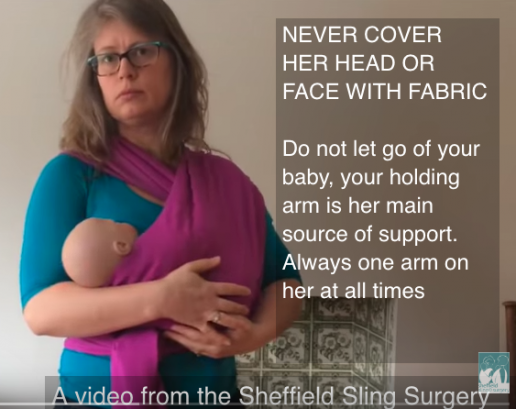
A hip carry may work well (with a wrap/ring sling/cross strap buckle carrier/meh dai).
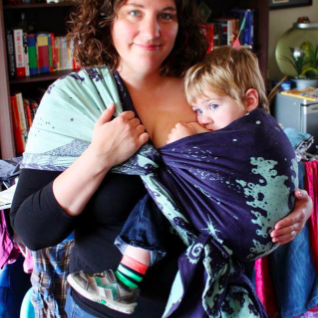
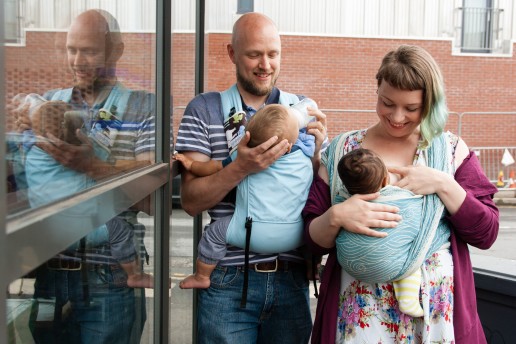
3) How can you make feeding in a sling as easy as possible?
For breastfeeding, think about ensuring easy access for your baby. Your choice of clothes can make things a lot easier. Loose fronted tops that can be easily moved out of the way, pulled down or lifted up, or those that open and close with zips or poppers, rather than buttons can help. Many mums swear by a combination of a loose shirt that can be lifted up/pulled down with a stretchy camisole or vest underneath that can be lifted up/pulled down. Such layering often provides good cover, if required. Bras that are easy to undo one handed (while your other hand supports baby”s head) are also helpful. Some mums find latching on more successful if they lean forwards slightly to bring the breast up to baby’s mouth, and many need to hold their breast up with one hand for the duration of the feed. Hoods can help with providing some discreet coverage, but remember that temperatures inside slings rise quickly if air cannot circulate freely, and carbon dioxide levels in rebreathed air are raised.
4) What kind of slings are good for breastfeeding in?
It is usually possible to feed a baby in most slings, with a bit of care. I don’t think there is really any such thing as hands-free feeding, as one hand or arm should always be on your baby to provide support, especially before they have excellent head control. But one hand free is better than none! Breast size, shape, flexibiliity and nipple position varies from woman to woman, and from stage to stage in the breastfeeding journey, so each dyad will need practice to work out which height works best for them. Larger breasts may prove more tricky for some.
Please remember that baby’s back and occiput should be well supported with no curling over and his chin should not be resting on his own chest, and once finished feeding, baby will need to be returned to his previous snug, upright and close position, by adjusting the sling appropriately.
Feeding in Stretchy Wraps
There are many different ways to feed in a stretchy wrap. Some methods are safer than others. On the whole, stretchy wraps are mostly used with small babies in the classic upright “hug hold” also known as the “pocket wrap cross carry”. It is these young babies from birth to four months who have the greatest risk of airway obstruction, so it is worth visiting your local babywearing consultant to get some advice and support if you can. I can’t stress enough how important it is to ensure your baby’s back and head is well supported, but still able to move freely to create an effective latch (and delatch), and that baby’s face is visible, not covered with fabric and their nose is clear. Once the feed is over, baby MUST be returned to the previous snug, close, upright seated squat position. There should NEVER be any fabric behind the back of baby’s head.
The video shows how to use a stretchy as a breastfeeding aid. You can see how baby is in the classic tummy to mummy position as the fabric is removed.
I usually advise parents to see their stretchy wrap as a breastfeeding aid. It can add a layer of extra support and spread some of the weight to the non cradling shoulder, and allow a short period of moving around while their child is feeding. It is not hands-free.
Feeding in ring slings
Ring Slings and upright feeding
From a good seated squat position, the pouch can be gently and slowly loosened by lifting the uppermost ring up carefully, so that baby is lowered slightly down your body. Ensure that the loosening is equal across the width of the sling so that baby’s upright seated squat position is maintained. Bring your child to the breast up so he is able to latch on without twisting his neck.
- Bottle feeders may not need to lower their baby as much, but some loosening will help to ensure baby does not have to twist his head to the side too much for teat access.
.


Ring Slings and slightly reclined feeding
From the snug seated squat position, loosen the fabric slowly and carefully to lower baby just a little. Lean forwards slightly and support baby’s upper body with one hand. Gently recline your baby into the waiting crook of your arm as you bring his far leg around to your front so both legs are together. Ensure the pouch of fabric is well tucked up between your baby’s side and your tummy so he is resting as if in a hammock, slightly turned towards you, bent knees above bottom, feet outside the carrier, with his head and neck resting on your arm. Adjust his location in this position so his mouth is able to reach your nipple – it should look and feel just as if you were holding him in your arms to feed. Keep the top rail of fabric under baby’s neck, do not pull it over his head.
- Bottle feeding is similar, but baby’s head will be facing the ceiling.
Feeding in Woven Wraps
Woven wraps and upright feeding
Carries such as the Front Wrap Cross Carry and its variants can be easily adjusted for feeding. The knot at the back (or side) can be loosened just a little, with the resulting small amount of slack worked equally and evenly back along the fabric so baby is sitting in a lower pouch with mouth above nipple, but still snug and supported, and in the spread squat position. The whole carry can be moved slightly across to one side or the other, and the baby can then be brought to to the breast. It is easy to switch sides.
Hip carries (especially those with slip knots) are easy to feed from one side.
Bottle feeding is similar, but baby may not need to be lowered quite as much, and may need a little more space at the top edge for the bottle to be accessible without baby’s head having to turn too far.
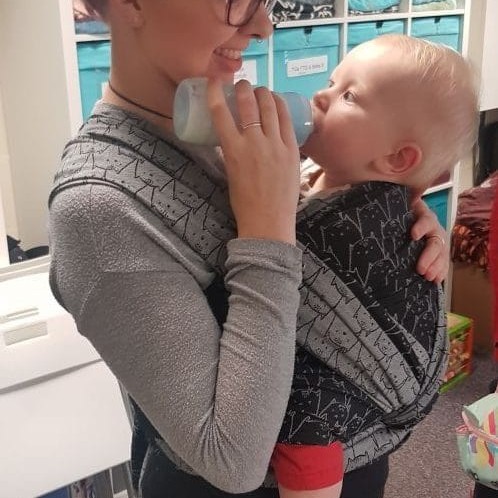
Woven Wraps and slightly reclined feeding
This works best with carries that do not have cross passes under baby’s legs, so baby can be gently tilted to one side to rest on your feeding arm. The FWCC can be partially untied so the long tails are hanging down over the shoulders and baby is sitting just in the horizontal pass. He can then be carefully gathered to one side with his far leg brought round to the front, his body turned to face the parent, bent knees above bottom, feet out and head and neck resting on your arm. Adjust his location in this position so his mouth is able to reach your nipple – it should look and feel just as if you were holding him in your arms to feed. Keep the top rail of fabric under baby’s neck, do not pull it over his head. The long tails are usually best left loose as retying them will mean you are not in control of baby’s head during the process.
- Bottle feeding is similar, but baby’s head will be facing the ceiling.
Feeding in soft structured carriers
Soft structured carriers (mei tais, half buckles, full buckles) and upright feeding
This can work well for bigger babies who have some head control. Baby should be in the carrier at the height she would normally be carried, with back and legs comfy in the seated squat position. To feed, slightly loosen the waistband gently and lower it a couple of inches and retighten, then loosen the side buckles or ties one by one to lower baby to the required position. One side may need to be loosened more than the other as baby feeds from that side. The breast can then be brought to the mouth. It is usually easy to switch sides with the straps being adjusted each time to allow baby to move. Baby’s back and occiput should be well supported with no curling over and his chin should not be resting on his own chest.
- Bottle feeding is similar, but baby may not need to be lowered quite as much, and may need a little more space at the top edge for the bottle to be accessible without baby’s head having to turn too far.
Once finished feeding, baby will need to be returned to the previous snug, upright and close position, by adjusting the sling appropriately.
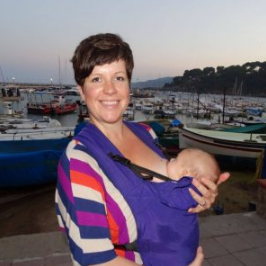
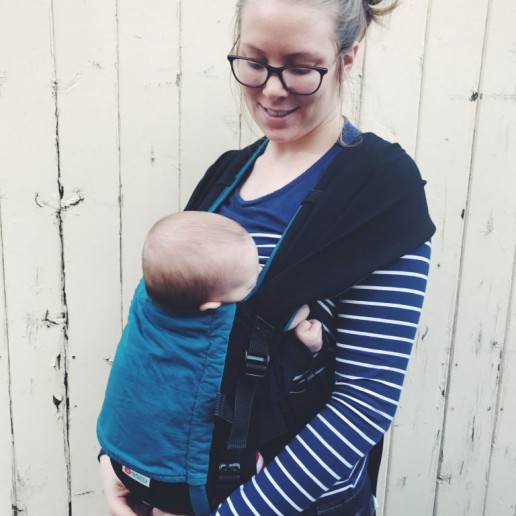
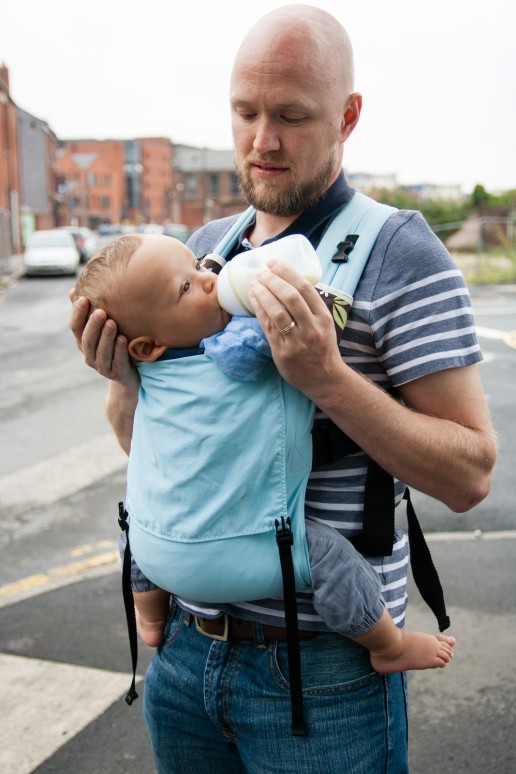
So in summary.. “Can I feed my child in my sling?” The answer is a resounding YES YOU CAN, from newborn to toddler, in lots of positions, from breast and from bottle. The key to doing it well is to ask questions about how to do it safely and empower yourself with knowledge to make a choice about how you wish to feed and then practice. It’s all about the AIRWAY! Do ask your local sling professional for some support…. – and enjoy!
Some further reading;
Seven Reasons Why Carrying is Great for Breastfeeding Mothers (Jess Hippey for Oscha Slings)
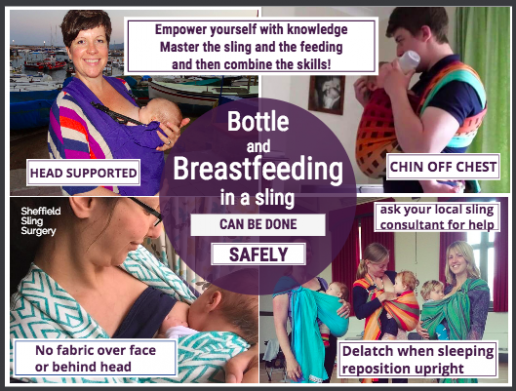
Summer Slings and Keeping Safe in The Sun - Carrying in the Heat
Summer slings and keeping safe while carrying in the heat is a hot topic among regular sling users. Carrying in warm weather can be hot and bothersome!
“Can I carry my baby in this heat? We are getting way too hot with our sling!” is a question I am asked many times in the few warmer months we get in the UK. Babies are warm little creatures, and in the summer humidity, they can feel like hot-water bottles on your chest. Many parents worry and stop using their slings in the summer as they don’t enjoy the sweatiness and stickiness that can come with hot-weather babywearing, and then miss the closeness. Sometimes children insist on being carried, so you get hot anyway, or pushchairs aren’t an option.. so what is a parent to do?
First of all, don’t worry. You won’t overheat your baby by carrying him. Women have been carrying in the heat for generations, in far hotter climes than the UK, they carry their children daily and come to no harm. The body is able to thermoregulate appropriately. However, there are a few things you can do to make the experience more pleasant for you both.
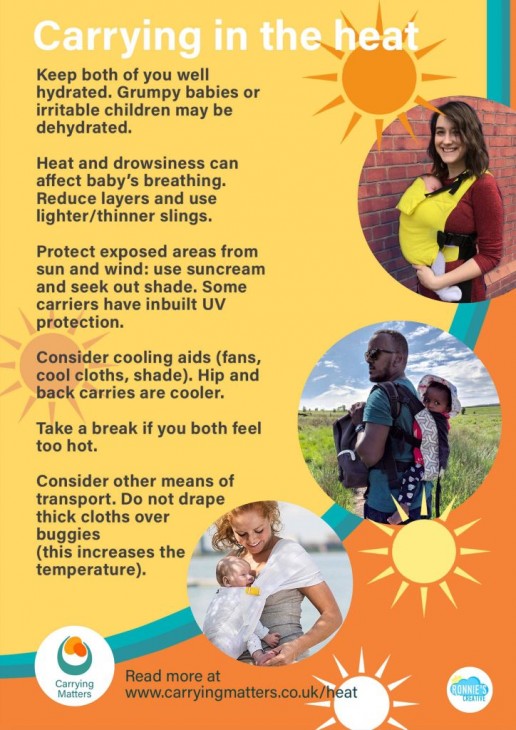
1) You and your baby need to be safe in the increased temperatures.
- Keep well hydrated. Baby needs to replace all the fluid she is sweating out – don’t underestimate her need to drink or breastfeed in warm weather. Take frequent breaks from your summer activity to check on your child and allow this re-hydration. Breastfeeding mums will need to increase their own fluid intake to compensate for the higher milk demand (breast milk becomes more watery and thirst-quenching in hot weather, amazing!) and everyone will need to drink more. Exclusively breastfed babies can get all their fluid requirements by frequent feeding and are unlikely to need any other fluids if they are feeding well. Bottle fed babies may well need some cool boiled water in addition to their formula. Sweating actually helps to cool the body down, by using the heat beneath the skin to evaporate the moisture. The better hydrated you are, the easier it will be to provide sweat. Adults are better able to thermoregulate than small children, so you can actually help to cool your hot child down by skin to skin.
- Think about the clothing you’re both wearing. Layers of clothes trap air, and therefore can keep heat in in cold weather.. so in hot weather, wear less layers on yourself, and reduce your child’s clothing too. Natural fabrics tend to be cooler – pure cotton, linen, bamboo allow breathability more than man-made fabrics and tend to cause less stickiness. The sling counts as layers of clothing, so take that into account.
- Protect your child from sunburn and windburn. Muslins can be draped over exposed legs or heads – but they are very thin and babies may still burn through them if not careful. UV protection covers from Snooze Shade can help for buggies. Hoods can be a mixed blessing in hot weather, as they can trap warm air when closed, thus increasing the temperature inside the carrier and reducing the flow of air around. A light, tie-on broad brimmed hat with neck coverage is often a better option. Clothing can help – lightweight long sleeves can add protection. Some slings provide mechanical protection from the sun, and some have UV protection features as well. Suncreams are an important part of caring for your child’s health (especially if they fall asleep and you are distracted.) Please check your sun cream is appropriate for your baby’s age and skin. Parasols can provide some shade.
- Cooling aids can be helpful. Some people will place a cool, damp muslin between their bare skin and baby’s, for coolness (others will use dry muslins to wick away sweat). Handheld fans can be very useful to blow cool air around. Sometimes people will use cool-packs to lay against skin every now and again, for brief periods. (I think this is safer than using freezer blocks in carrier pockets next to baby skin. Frozen peas against an ankle begin to hurt after a few moments, and babies may not be able to communicate the source of their discomfort well enough.) Splashing cool water can provide some relief… and regular breaks from the sling in the shade should be part and parcel of ensuring everyone is comfortable.
- Choose the time of day you use your carrier and consider other means of transport. It may be useful to just use your carrier in the cool of the morning or for evening strolls rather than carrying in the heat of the midday sun. Parasols may offer some shade as you walk along. Some parents and children may dislike the sweatiness that comes from close contact in slings and may therefore feel cooler with in arms carrying, or in a pushchair. If you use a buggy do make sure that the seat itself isn’t hot from the sun and that you allow plenty of fresh air inside the chair as temperatures can rise very quickly indeed. The sun cover may indeed keep the sun off but can also trap heat and carbon dioxide due to the reduced air circulation, which can be dangerous for children. The Snooze Shade offers a safe way to protect babies in buggies
Such measures may go a long way to making you and your baby feel a lot happier in the sling that you have.
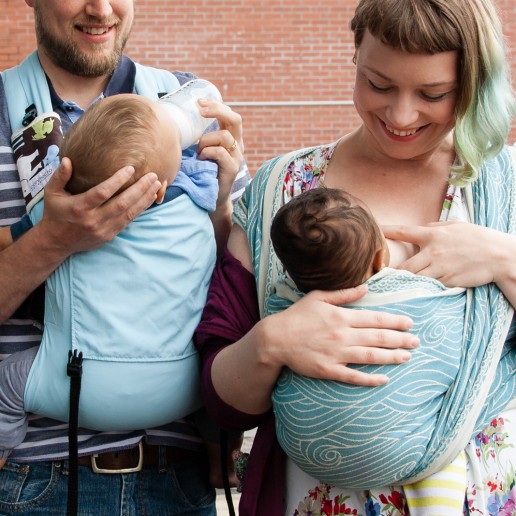
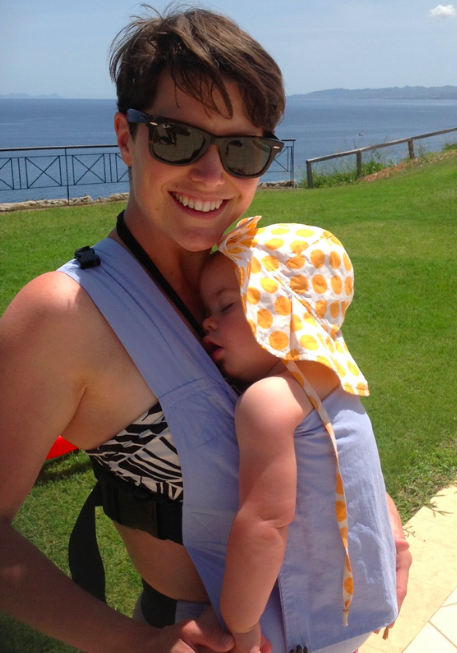
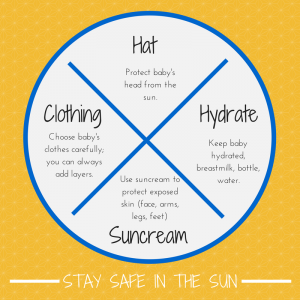
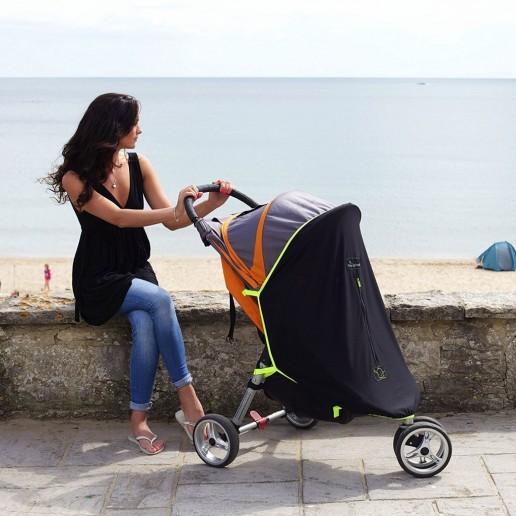
2) Use your current carrier in a way that is more appropriate in hot weather
Please note that each suggestion may not work for every situation. If you are unsure and would appreciate some more help, do get in touch with your local sling consultant/library for some support! The Sling Pages has a comprehensive list of such resources.
Stretchy Wraps
- When stretchy wraps are used with the classic pre-tied Pocket Wrap Cross Carry, it is best to have three layers across baby. This is because the elastic nature of the sling does not provide enough support with only one layer, and two cross layers can be easily divided by a baby pushing away or arching backwards. If you want to use your pre-tied stretchy in the PWCC or a hybrid stretchy carrier with just two layers, ensure the cross passes are well distributed from knee pit to knee pit and up to the neck on both sides, be well aware of the risks and be vigilant of your baby’s movements, especially if you are likely to be distracted.
- You could try using a thin gauze scarf in place of the third layer of hybrid stretchy carriers.
- Front double hammock carries and hip carries (two-layers) are an option. They can be harder to master.
- Seated sideways carries may reduce the body surface contact.
- If you are using an old-style stretchy wrap folded in half (six layers), try using it unfolded (three layers).
Woven Wraps
- Try single layer front carries to reduce the number of layers over baby, such as a kangaroo carry which can have open sides.
- Try hip carries to reduce the amount of fabric around your body.
- Try high back carries (this may reduce surface area contact).
Ring Slings/Mesh slings
- These are often cool anyway. Try a seated sideways position to reduce the amount of surface contact.
- Try a back carry or a torso carry which may feel cooler.
- Fold the shoulder fabric that is cupping your shoulder over itself a little to reduce the coverage across your upper back. Flipped shoulders can also help with this.
Meh Dais/Half Buckles
- Try using your meh dai with the passes unspread across baby’s back (ensure the bunched up passes are not too tight and rubbing into his knee pits) to allow some airflow at the sides.
- Try a hip or back carry.
Buckle Carriers
- Try a hip carry, if your carrier has this functionality.
- Try a back carry if your baby is able to sit unaided (enough upper body strength).
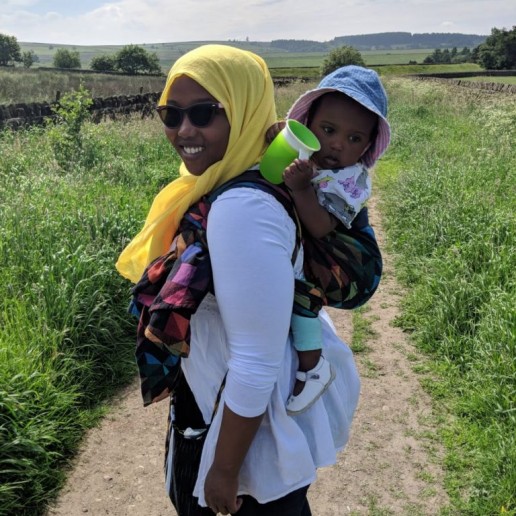

3) Try a carrier that is more suited to the weather
Your local Sling Library may have a few options you can try out for carrying in the heat – it is always worth investigating to see what works for you and your baby comfort-wise. Sometimes hiring for a holiday may be cheaper than buying a new sling!
Stretchy Wraps
There are several lighter weight stretchy wraps available which will feel cooler than the heavier, thicker brands. Bamboo is breathable and cooler, and look at how thick the fabric is before you buy. Stretchies are wonderful for little babies but need a minimum of two, ideally three layers. Some hybrid carriers have mesh panels which can reduce warmth.
Woven Wraps
Lightweight wraps (usually those with a lower density (the g/m2) are cooler and lighter than thicker and heavier ones) can be very useful. Gauze wraps are thin and cool and good with smaller children. Thin cotton wraps are also an option – but may not be as sturdy for bigger children. There are many supportive, lightweight , breathable cotton wraps around and some brands make special lightweight cotton blends with special fibre types for strength (eg “ice cotton”).
There are thick and thin versions of almost every combined blend of woven wrap available, so it is worth doing some research into the thickness and density. Traditionally, linen, hemp and silk are used to add strength and sturdiness to the softness of cotton, and can be lovely lightweight toddlerworthy wraps, but some blends can be thick and warm. 100% linens are often cool and supportive, and loose weaves can be airier than dense ones. Some people find merino blend wraps cool in warm weather, as the breathable wool wicks moisture to the surface to be carried away.
Learning how to use a shorter wrap may be another way of reducing the amount of fabric wrapped around your body.
There are a few mesh wraps around, such as the Fil’Up, which can be very cool to use.
Ring Slings/Mesh Slings
Ring slings or mesh slings like the MiniSling are a great option in warmer weather, as they can be quick to take on and off and only cover half of your body. They are single layer slings, too. Again, like any woven wrap , the fabric involved can make a difference to its warmth. Lightweight muslin ring slings, 100% linens or thin but strong cotton/blends are a good option here. Be cautious about buying thin ring slings from eBay or from non-recognised retailers. There are mesh water ring slings which can be useful in the water, but can also be a little sweaty in dry, hot conditions due to the fabric used. Simple pouches can be a good option as well, if used safely in an upright position, and there are several mesh carrying aids like the Suppori and the Tonga which can help take some of your child’s weight and remain cool. Carrying aids are not hands free, however.
Meh Dais/Half Buckles
Sometimes these can feel warm, if there are multiple layers of fabric in the panel or if the fabric used is thick and dense. Sometimes lighter weight meh dais/half buckles can work well, tied in ways that allow airflow at the sides or with straps not spread across the whole of the parent’s back.
Buckle Carriers
Some buckle carriers are designed for hot weather use, either in the lightness of the fabric they use, the lack of padding, or their design (mesh panels etc). Some people will find rucksack style carriers less warm than cross strap carriers, as there is less padding across the back (when used in front carries). Solarweave fabric is useful and some carriers make a feature of their UV resistant fabric too. Some carriers have lightweight mesh panels or less padded straps, or thin waterproof fabric . Those with thick padded waists may feel just as hot to wear as their standard counterparts.
In summary, yes you can carry your baby in hot weather, there are many things you can do to make it more enjoyable for both of you. Be mindful of your baby’s comfort and be careful of both your needs, and you won’t go far wrong!

